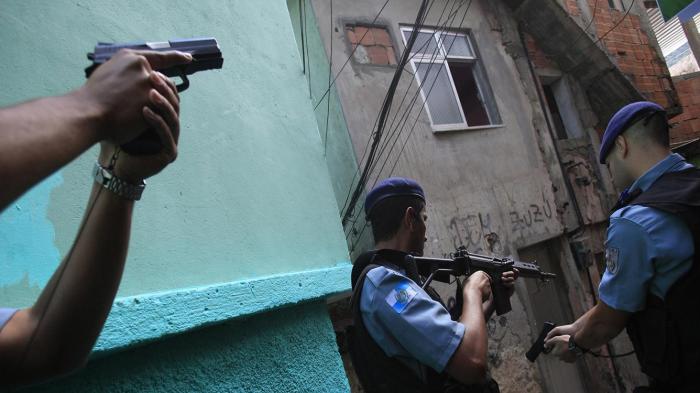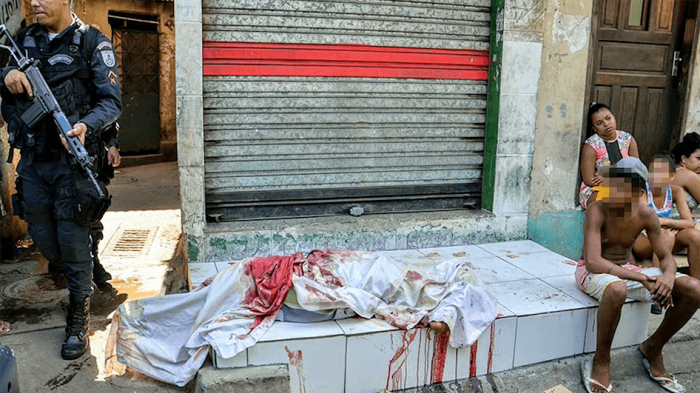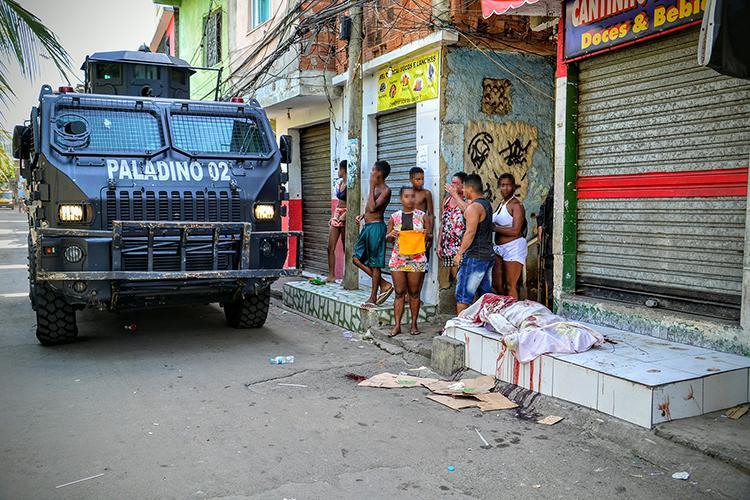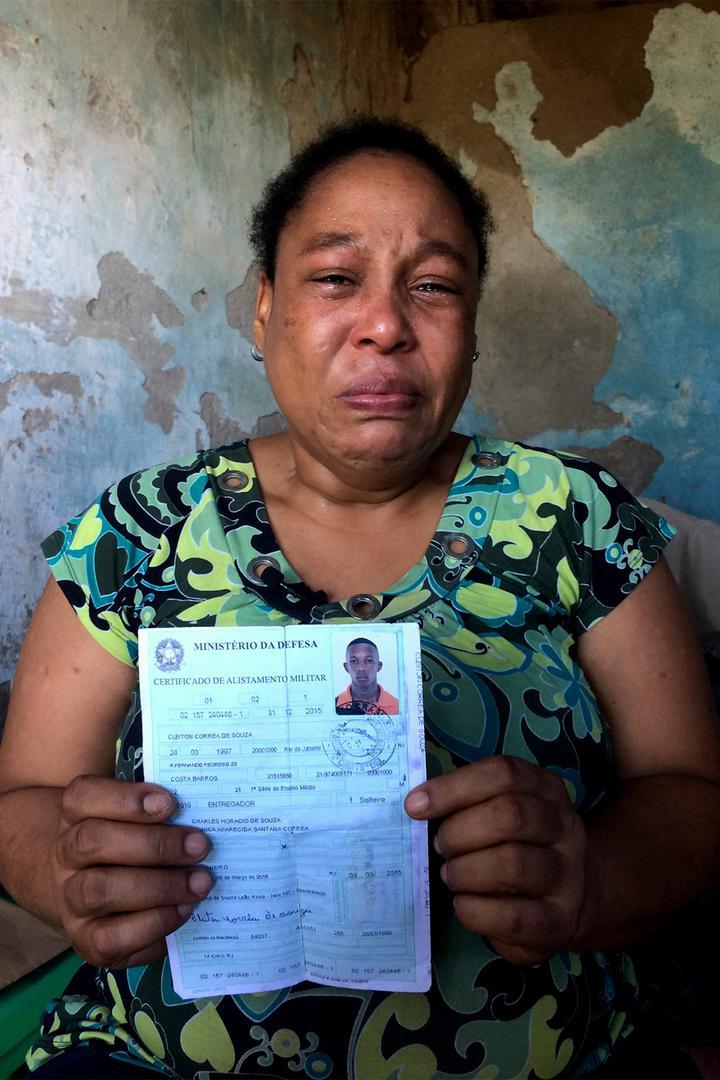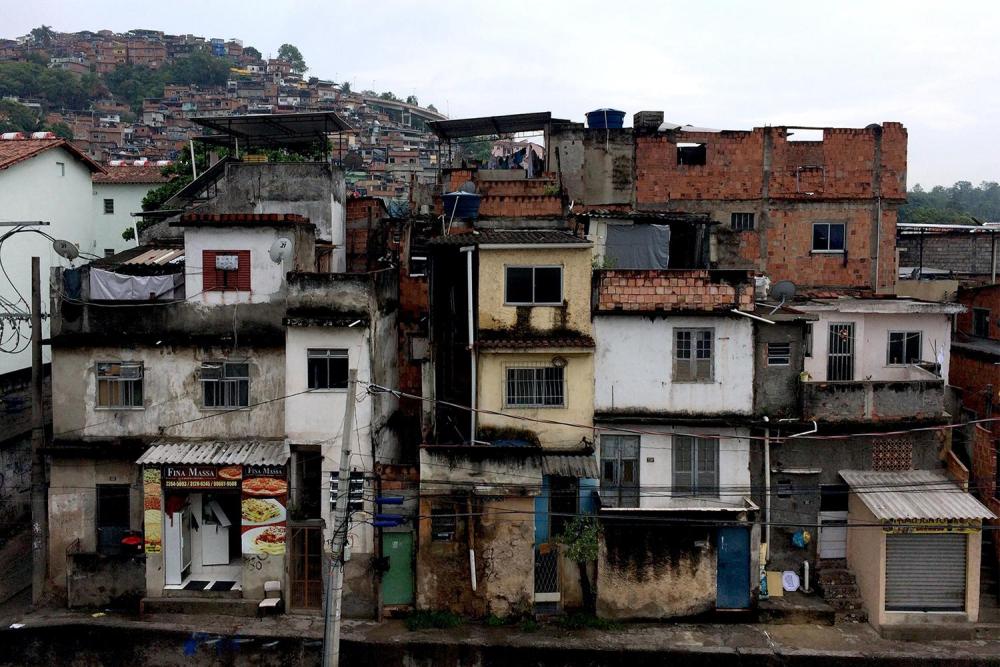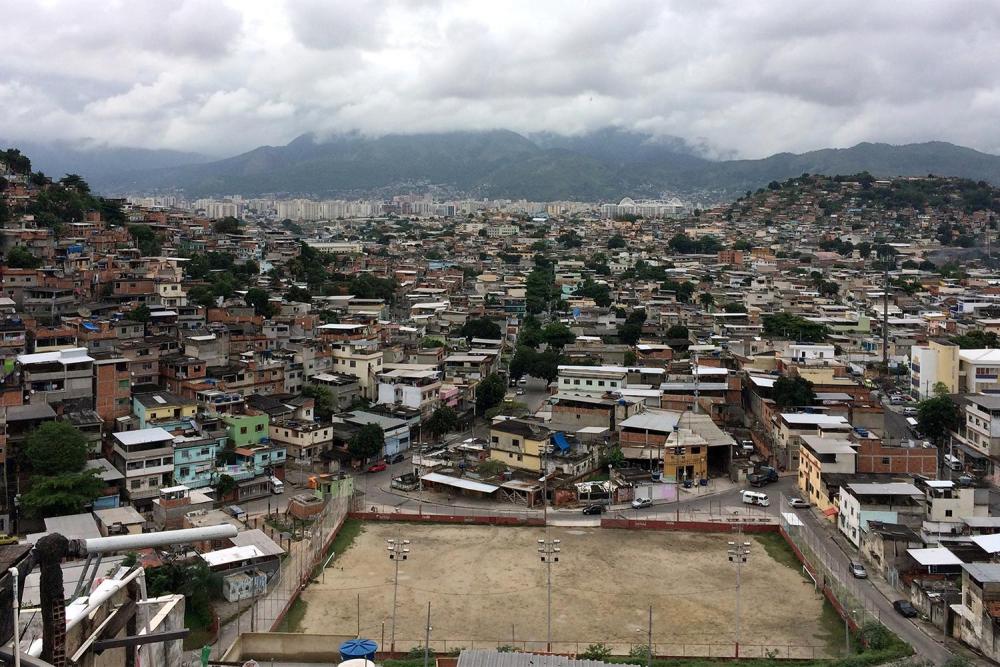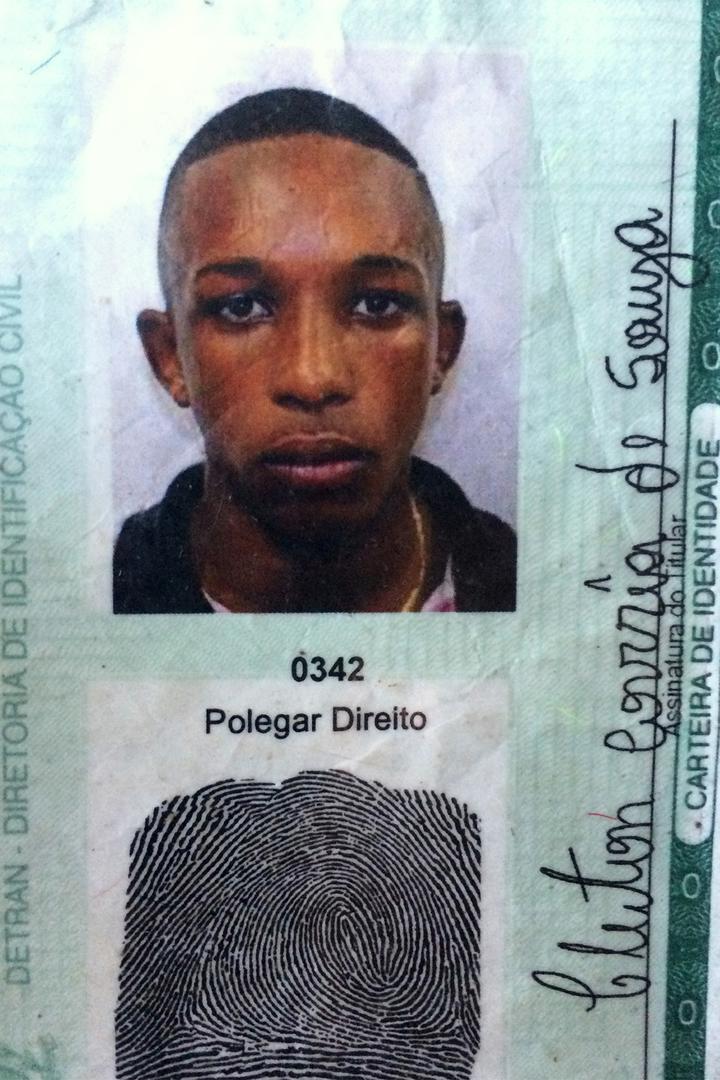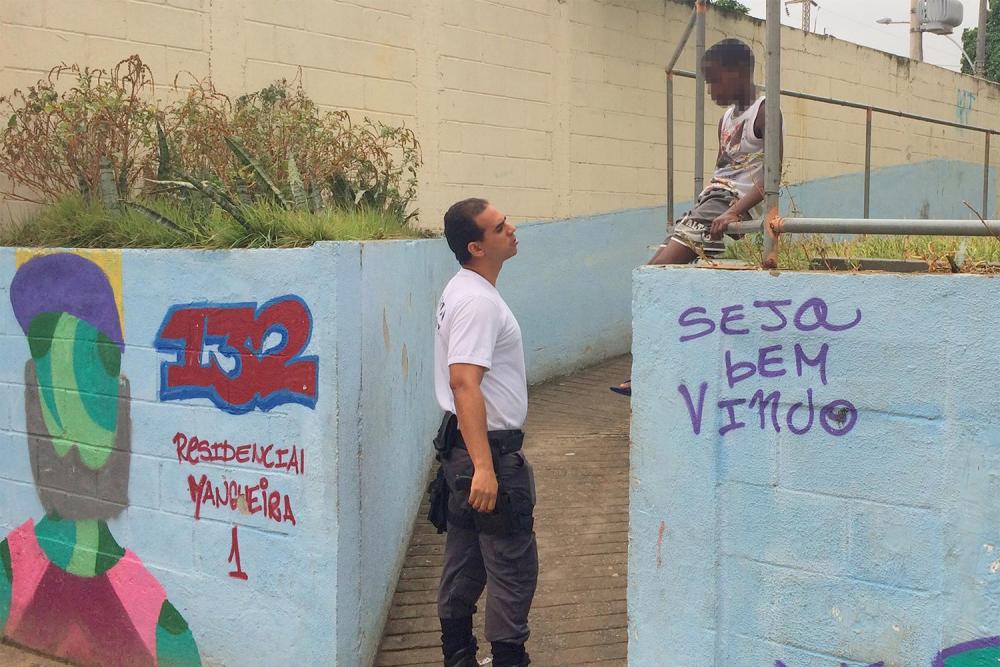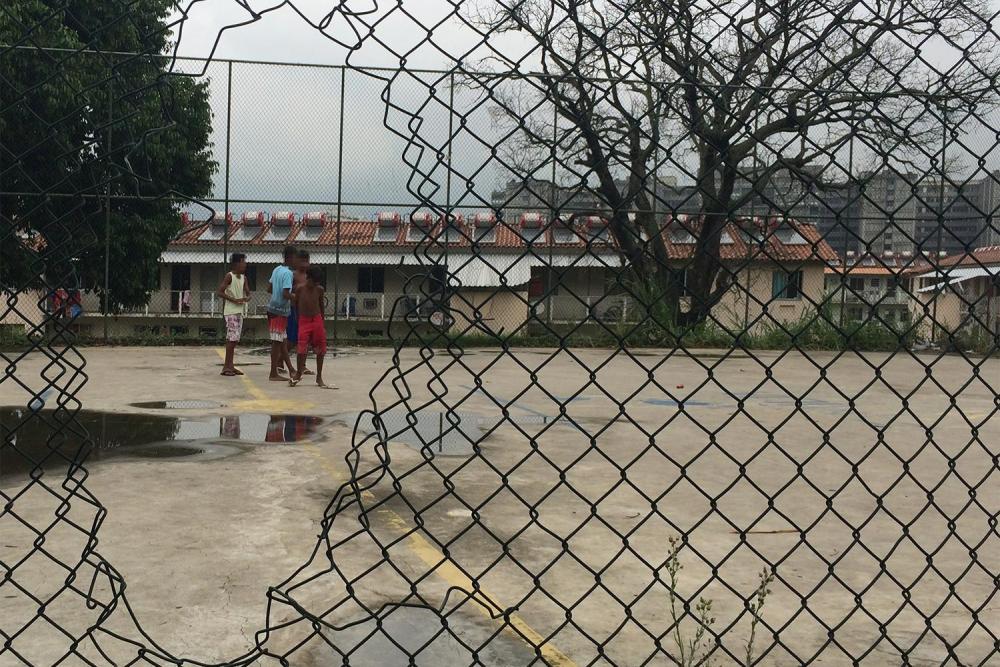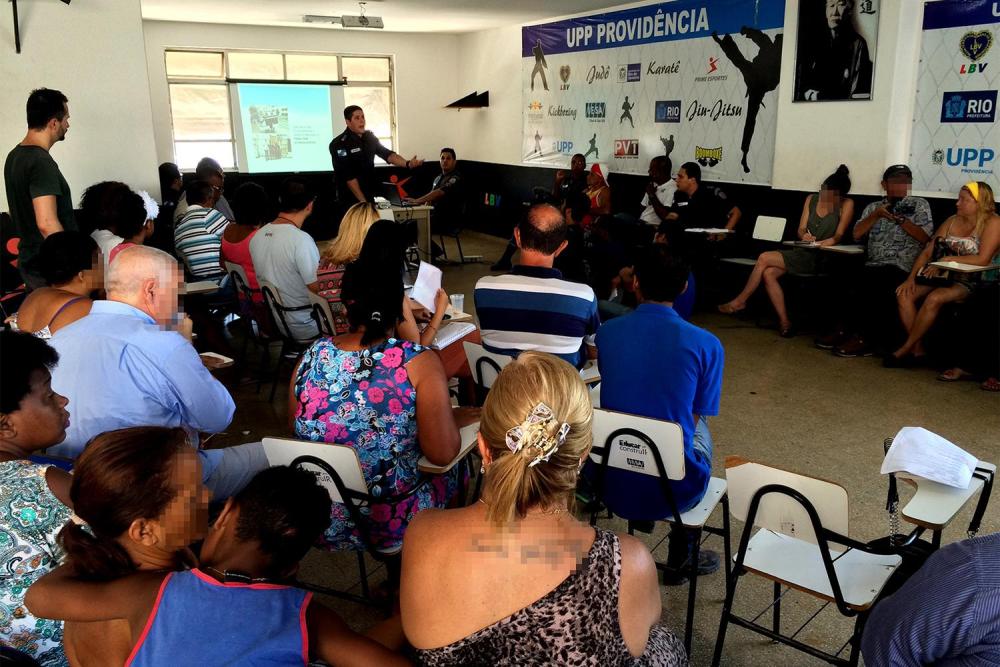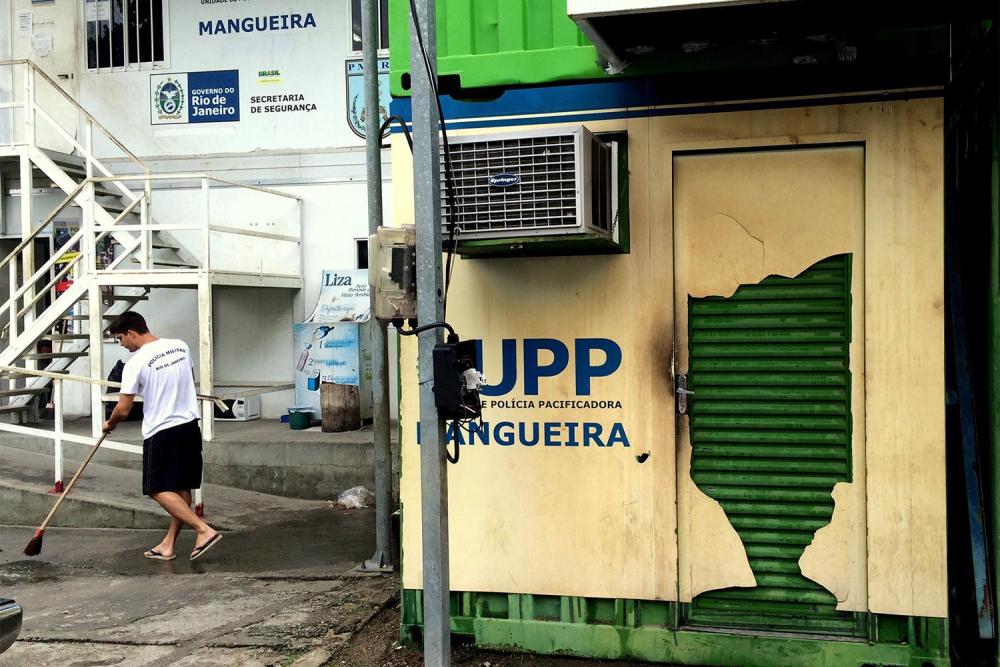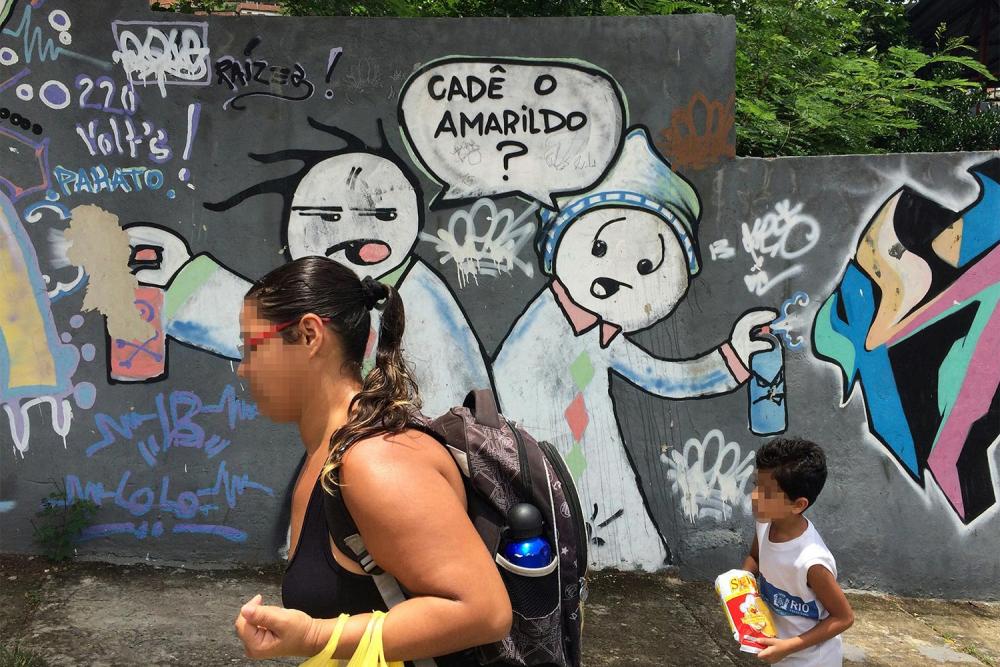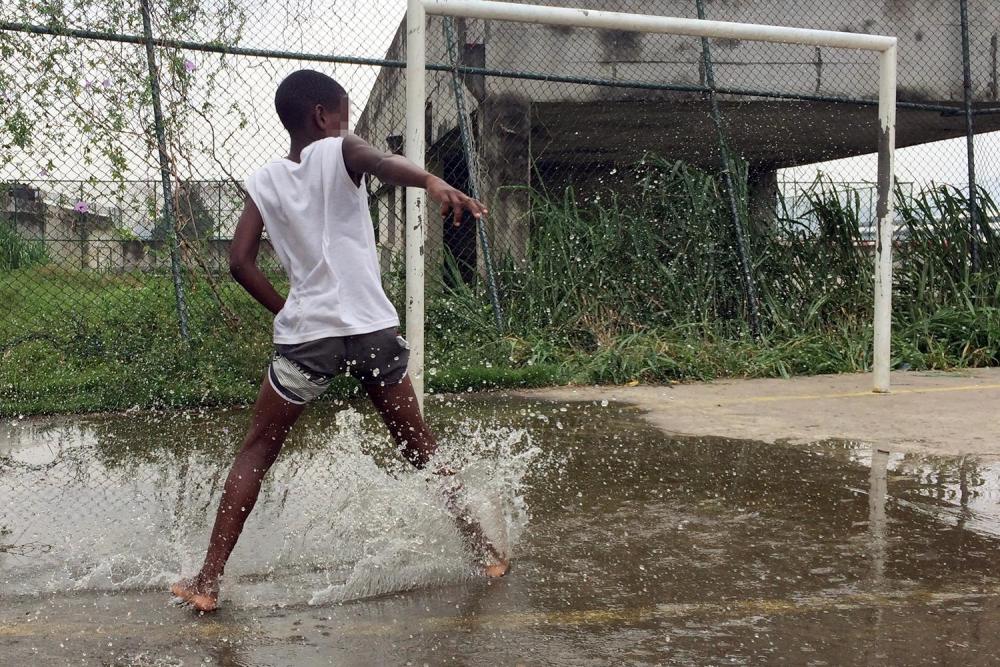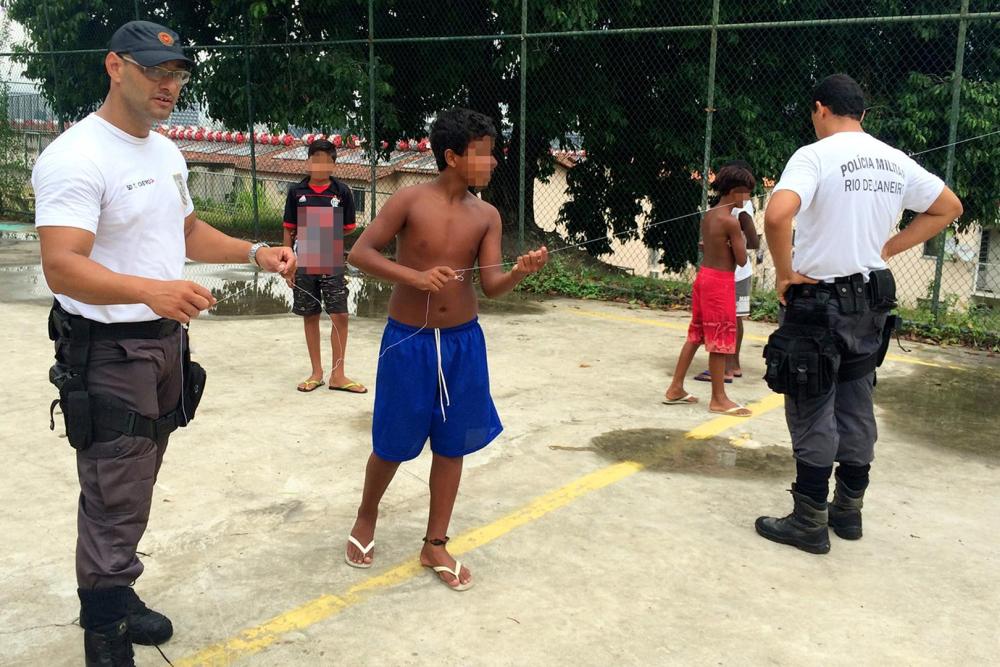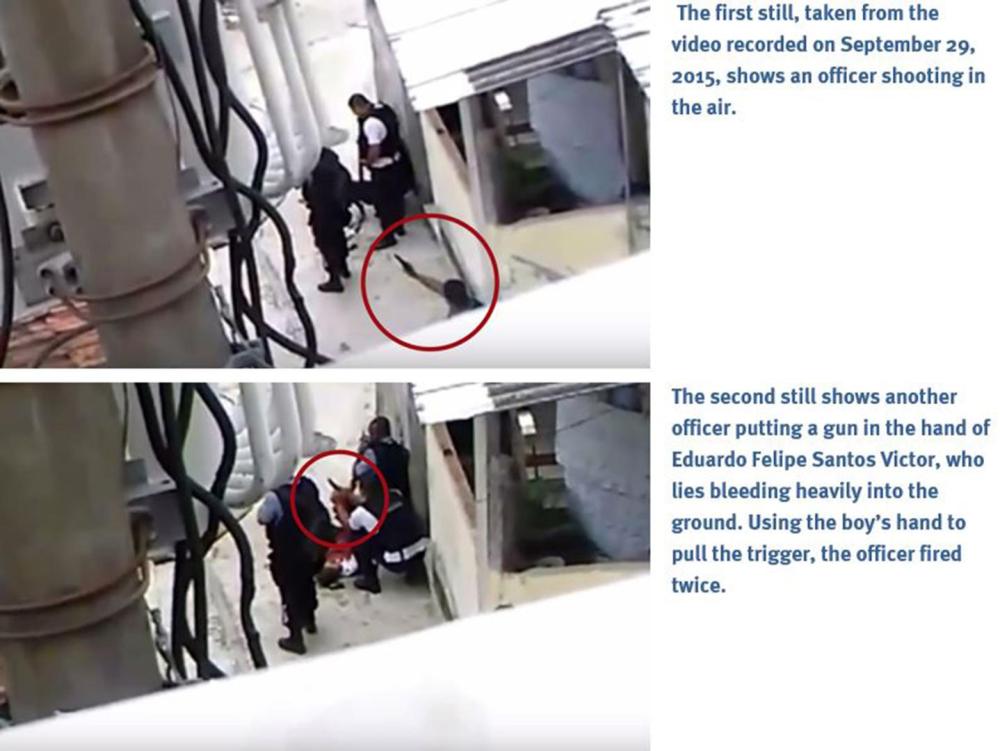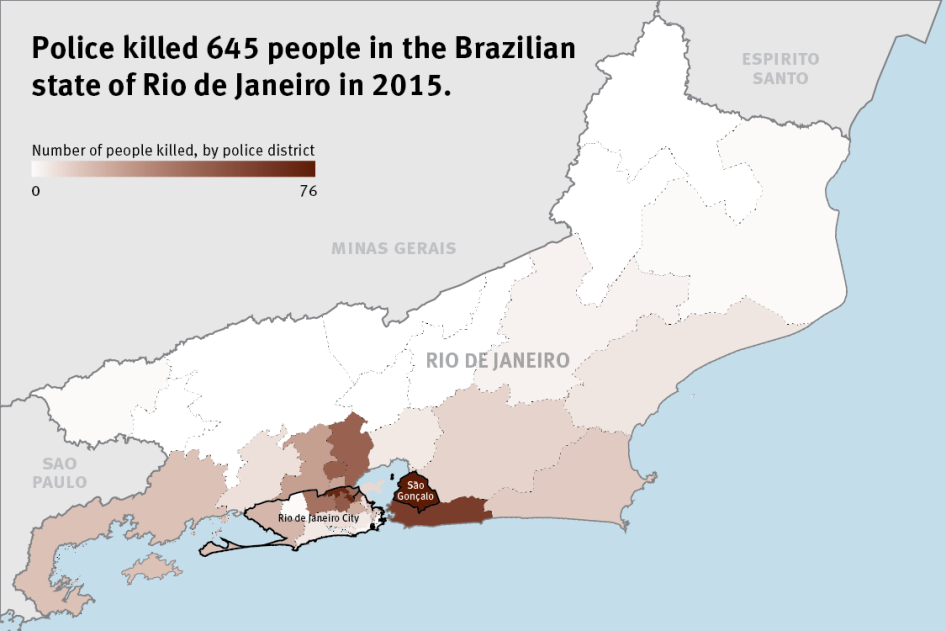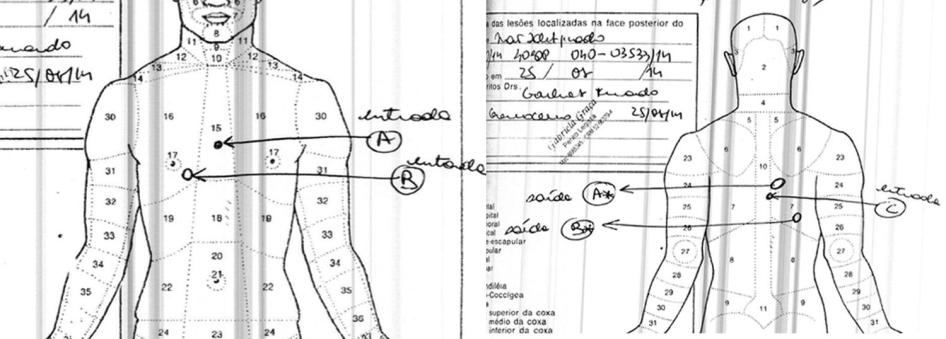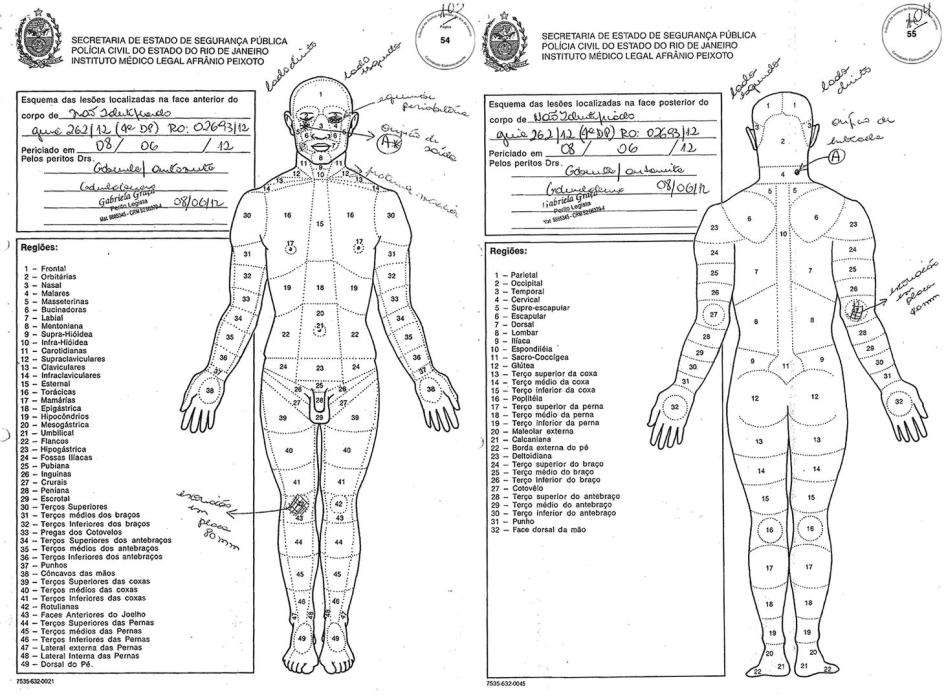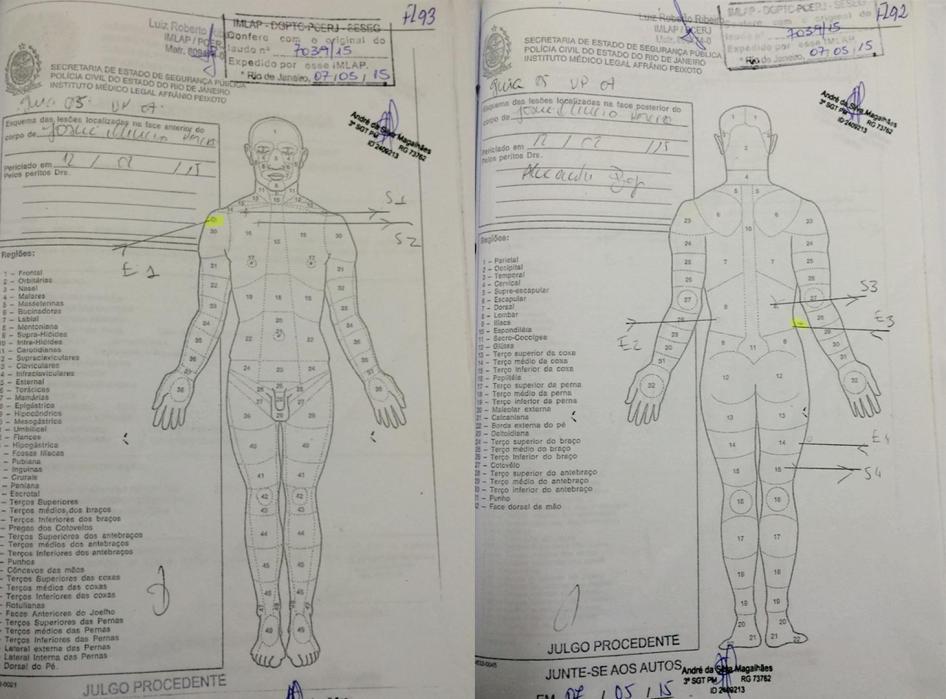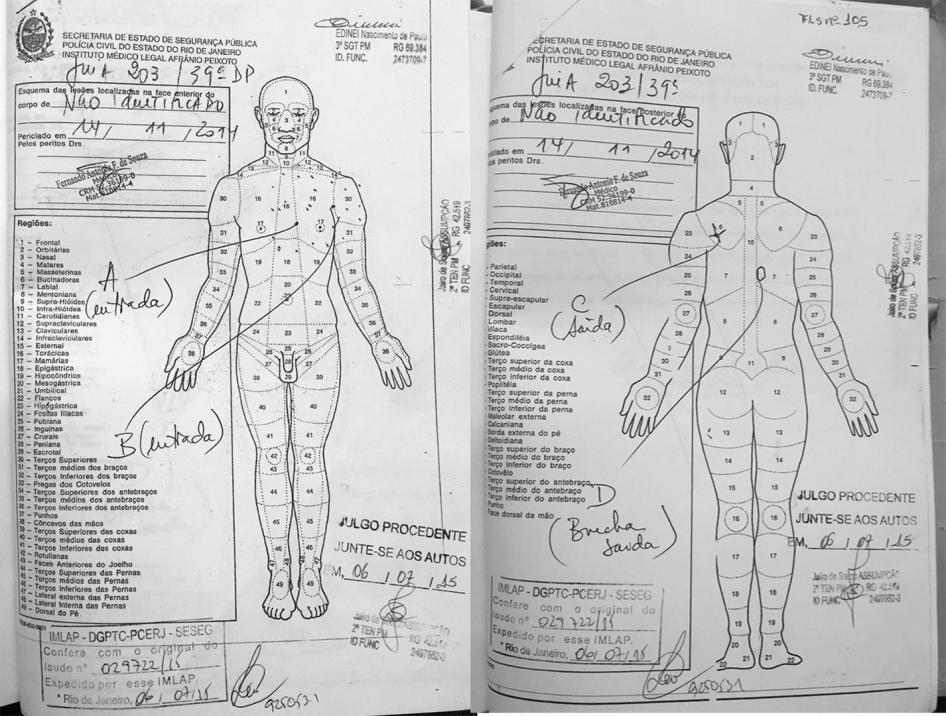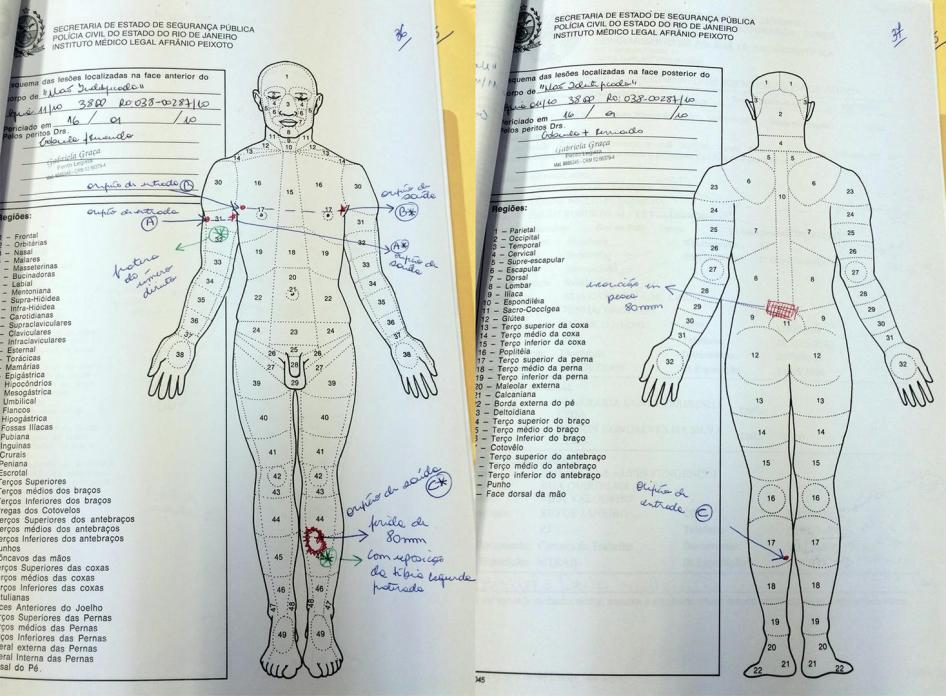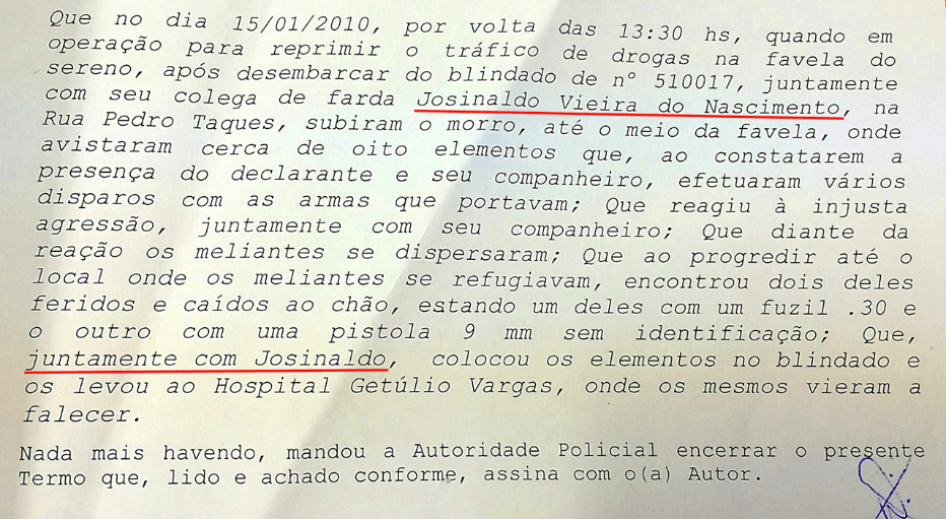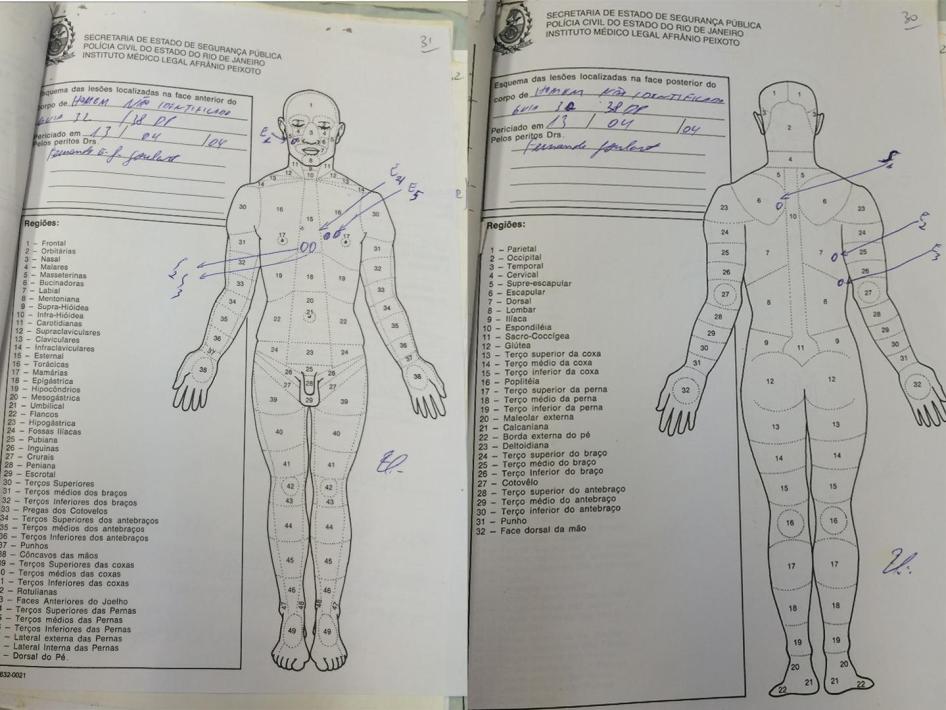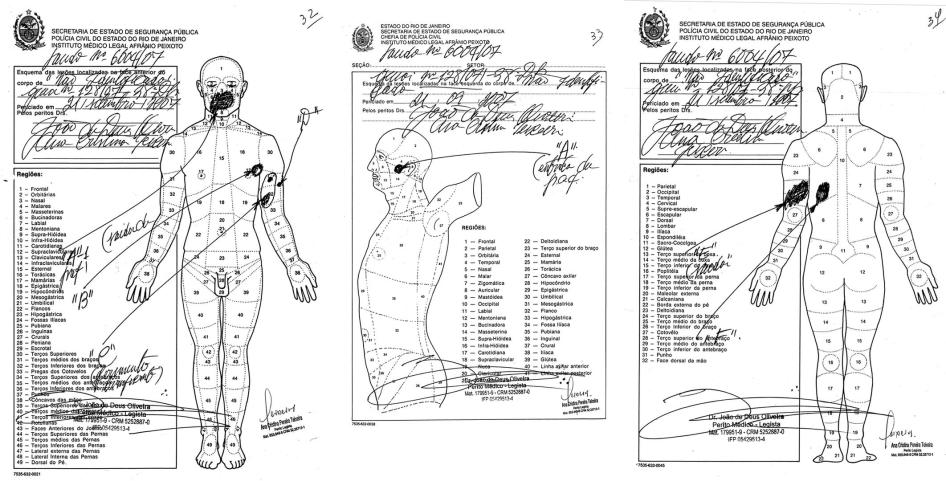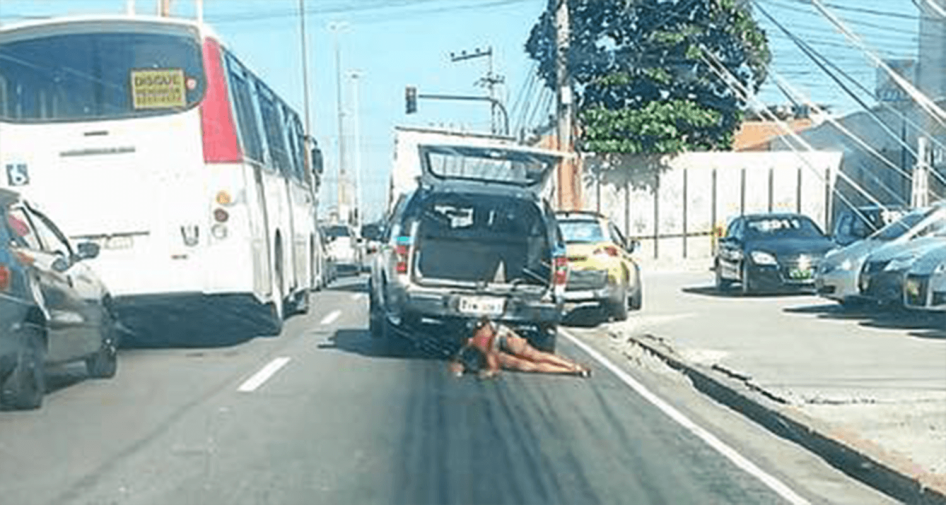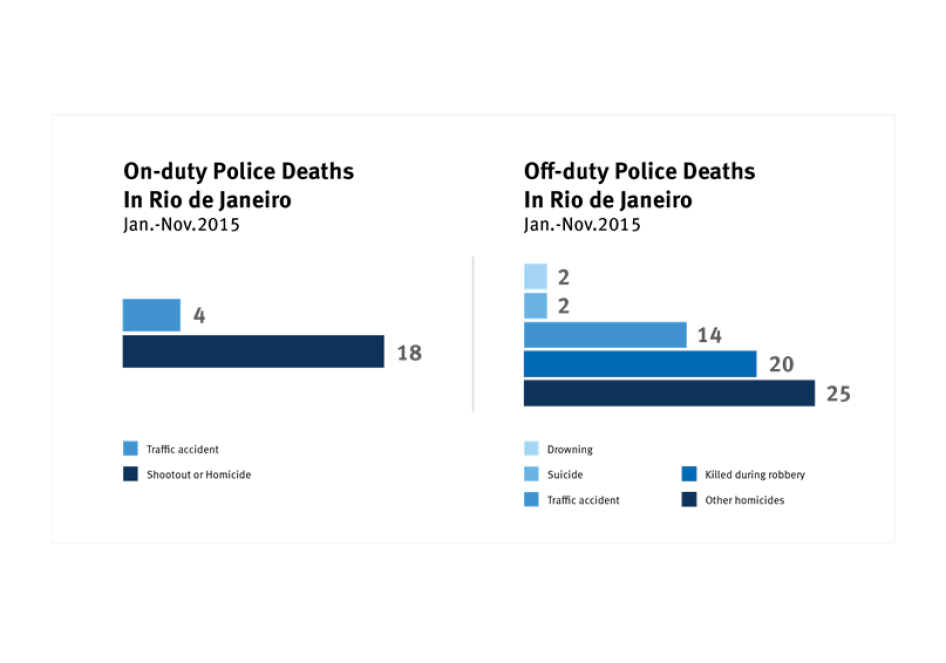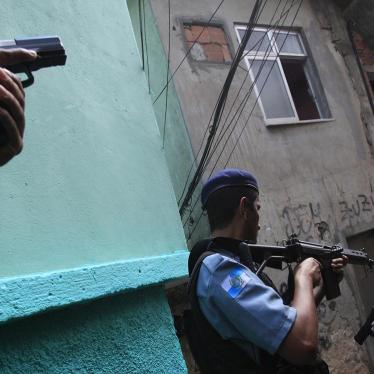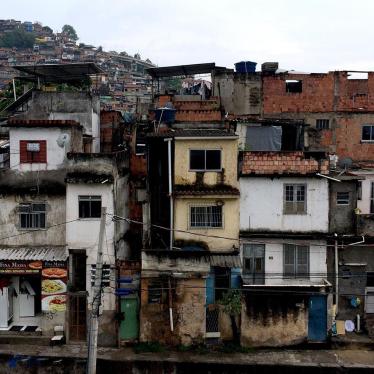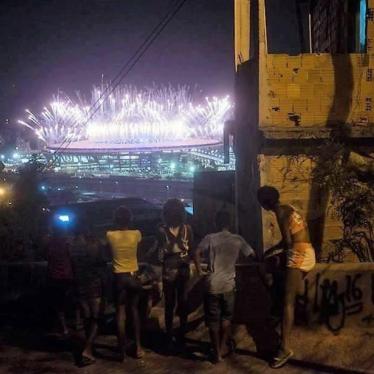Summary
Police in the state of Rio de Janeiro have killed more than 8,000 people in the past decade, including at least 645 people in 2015. One fifth of all homicides in the city of Rio last year were police killings. Three quarters of those killed by police were black men.
The Rio police report nearly all such killings as legitimate acts of self-defense in response to attacks by suspected criminals. Given that police in Rio often face real threats of violence from heavily-armed gangs, many of these killings are likely the result of the legitimate use of force.
Many others, however, are in reality extrajudicial killings. Police shoot at unarmed people. They shoot people in the back as they are fleeing. They execute people who have been detained with a bullet to the head.
Police officers involved in these unlawful killings routinely seek to cover up their criminal behavior. They threaten witnesses. They plant guns on their victims. They remove corpses from crime scenes and deliver them to hospitals, claiming they were trying to “rescue” them.
Human Rights Watch first documented this pattern of killings and cover-ups in our 2009 report Lethal Force, which exposed 35 cases in which there was credible evidence that police officers sought to cover up unlawful killings. Since then we have documented an additional 29 such cases, including 12 that occurred in the past two years. In these 64 cases, a total of 116 people lost their lives, including at least 24 children.
The 64 cases reflect a much broader problem, according to local justice officials, who told Human Rights Watch that a large number of the “shootouts” reported by police in the state in recent years were in fact extrajudicial executions. Official government data supports this conclusion.
To understand the causes and consequences of these killings, Human Rights Watch conducted in-depth interviews with more than 30 police officers, most of whom serve in favelas—as the city’s low-income neighborhoods are known—with high numbers of reported shootouts. Several recounted their experiences with the use of lethal force; two described participating in extrajudicial executions.
Unlawful killings by police take a heavy toll—not only on the victims and their families—but also on the police force itself. The killings fuel cycles of violence that endanger the lives of all officers serving in high-crime areas, poison their relationships with local communities, and contribute to high levels of psychological stress that undermine their ability to do their jobs well.
The officers responsible for unlawful killings and cover ups are rarely brought to justice. The state’s attorney general, Marfan Martins Vieira, told Human Rights Watch he believed a large percentage of the reported shootouts were “simulated,” but conceded that his office had prosecuted only a “very small” number of police killings. He blamed this failure on the poor quality of the investigations conducted by the state’s civil police.
It is true that, under Brazilian law, criminal investigations are initiated by investigators within the state’s civil police force, and that those investigations have been woefully inadequate. However, responsibility for ending this impunity ultimately lies with Rio de Janeiro’s Attorney General’s Office, which has legal authority to oversee the work of the police investigators, as well as to carry out its own investigations.
After releasing Lethal Force in 2009, Human Rights Watch presented its findings and recommendations in multiple meetings with authorities in Rio de Janeiro—including the then-governor, public security secretary, and the attorney general. In the years since, the authorities have implemented several of our recommendations as part of a much broader effort to improve policing in the state.
This broader effort—whose centerpiece was the implementation of a community policing model in high-crime areas—initially showed great promise. The numbers of police killings and overall homicides decreased significantly between 2009 and 2013. But this effort now appears to be unraveling, in large part because the state failed to address what is perhaps the most important factor in allowing unlawful police killings to continue: impunity.
Rio authorities have recently taken several steps to improve how cases involving police killings are handled—including, most notably, the creation of a special prosecutorial unit focusing on police abuse. These measures could have an important impact, but only if the state attorney general and public security secretary take additional steps—outlined in this report—to strengthen them. If, instead, these initiatives are allowed to fall short, it will be very hard for Rio to make real progress in reducing unlawful police killings and improving public security.
Police Officers’ Accounts of Executions
Human Rights Watch’s interviews with more than 30 Rio police officers revealed a routine disregard for international standards, Brazilian law, and internal police regulations governing the use of lethal force. Officers attributed the excessive use of lethal force to a pervasive “culture of combat” and corruption within military police battalions.
Several military police officers recounted their own involvement in violent encounters, including two who told of direct participation in executions. One described his participation in an operation in which a fellow officer executed a suspected drug trafficker as he lay injured on the ground, and said he feared he would be killed if he reported what happened. Another recounted an incident in which he and other police officers set an ambush for suspected gang members, gunning them down as they fled from other officers, then planted guns on their two victims as they lay dead and dying in the street. He also described participating in torture, an abduction, and receiving payoffs from criminals.
Unlawful Police Killings and Cover Ups
Human Rights Watch found substantial credible evidence that many persons killed in alleged shootouts were in fact executed by police officers.
In a majority of the 64 cases we examined, the officers’ accounts of the shootings appeared incompatible with the autopsies or other forensic reports. In at least 20 cases, the autopsy reports detailed gunshot residue patterns consistent with the victim having been shot at point blank range. In other cases, witness testimony or other evidence indicated there was no shootout.
In June 2015, for example, military police reported that they had injured a man in a shootout in the Morro da Coroa favela. The police took the man to the hospital, where he died. Yet an autopsy showed he had been shot seven times, at least once at point-blank range. And a witness at the scene of the shooting reported having seen the victim injured but alive on the ground, hearing a single burst of gunfire shortly after the police arrived, and three hours later seeing police take the victim’s lifeless body away.
While it is impossible to determine the precise scope of extrajudicial executions by police, official government statistics are consistent with the view of local criminal justice officials that the practice is widespread. The high number of police killings—more than 8,000 since 2006—is all the more dramatic when viewed alongside the comparatively low numbers of non-fatal injuries of civilians and police fatalities in those same incidents or areas of operation. This disparity suggests that in many cases police report killings as the result of armed confrontations that did not happen.
For each officer that died while on duty in Rio in 2015, police killed 24.8 people, a rate that is more than double that of South Africa and triple that of the United States. The disparity was even more dramatic in the 10 police districts with the highest number of reported “shootouts”: the police units in these zones were responsible for 483 killings in 2015 while suffering 15 police fatalities. Moreover, Rio police killed five people per each person they injured from 2013 to 2015, the reverse of what one would expect.
In the 64 cases we documented, police officers sought to cover up the criminal nature of the killings. One common technique was to remove a shooting victim’s corpse from the crime scene, deliver it to the hospital, and claim that the removal was an attempt to “rescue” the victim. These false “rescues” serve to destroy crime scene evidence while providing a veneer of good faith on the part of the police.
In some cases, police officers forged evidence by placing a gun in the victim’s hand and firing it, or planting drugs on the victim. Some officers threatened witnesses to discourage them from reporting what they have seen. In a case from July 2011, for example, police officers tortured and killed the 14-year-old son of the witness of an earlier execution in the Salgueiro favela as a means to intimidate her, according to prosecutors.
Impunity for Police Killings and Cover Ups
Only eight of the 64 cases that Human Rights Watch examined went to trial, and only four cases ended with convictions of police officers involved in the killings. In 36 of the 64 cases, prosecutors did not even seek indictments despite credible evidence that the police sought to cover up an unlawful killing.
All the state justice officials with whom Human Rights Watch spoke—including the attorney general—said police officers responsible for unlawful killings are rarely brought to justice. Official data lends support to their assessment, though a lack of up-to-date and reliable information makes it difficult to determine the precise scale of this impunity. The Attorney General’s Office reported to Human Rights Watch that it had filed charges in only four—or one-tenth of one percent—of the 3,441 police killings recorded between 2010 to 2015 (though in fact we documented 15 cases from these years in which prosecutors filed charges). The most recent state-wide study of prosecutions of police killings, coordinated by Michel Misse, a professor at Rio de Janeiro´s Federal University, found that of all the killings by police that occurred in 2005, prosecutors had, by 2007, filed charges in less than 1 percent.
Police investigators routinely fail to conduct proper inquiries into police killings, disregarding basic tenets of homicide investigation. In 52 of the 64 cases we examined, there was no record of the police investigators ever having conducted a crime scene analysis. Often they do not question all police officers involved in a killing, do not seek out and interview non-police eyewitnesses, and do not conduct basic forensic tests.
Brazil’s Constitution grants the Attorney General’s Office the legal authority to exercise “external control” of the police forces. This includes making sure the civil police conducts thorough and professional investigations when there is evidence that police themselves have committed crimes. Prosecutors have several tools at their disposal to ensure that police conduct more thorough investigations—from institutional pressure, to referral of officers who fail to conduct or impede investigations for disciplinary action, to, in extreme cases, criminal prosecution for malfeasance. Yet Rio’s Attorney General’s Office has consistently failed to use these tools and fulfill its constitutional responsibility.
Where civil police do not conduct adequate investigations, moreover, the Attorney General’s Office has the power to conduct its own independent inquiries, hear witnesses, and obtain evidence. However, the Attorney General’s Office has rarely used that power to investigate police killings.
Prosecuting police killings in Rio is possible, as was demonstrated in São Gonçalo, the state’s second largest city, between 2008 and 2001, when a judge, a prosecutor, and civil police officers made a concerted effort to address the issue. Prosecutors filed charges against 107 military police officers—about 15 percent of the troops in the military police battalion in São Gonçalo during that period. The number of police killings in the city subsequently dropped by 70 percent. Some police officers had warned that this effort to promote accountability would impede police work and result in a rise in crime, but the number of robberies and overall homicides in São Gonçalo also declined. Progress came to a halt when the judge was murdered by some of the police officers who were facing prosecution. In the absence of accountability, the number of police killings climbed again and is now higher than in 2008.
Toll of Police Killings on Law Enforcement
To serve as a military police officer in Rio can be extremely dangerous, largely due to the heavily-armed and violent criminal gangs that operate in many of the city’s low-income neighborhoods. Officers interviewed by Human Rights Watch described having to face these gangs with poorly-maintained weapons and vehicles, as well as inadequate training that leaves them unprepared to respond to life-threatening situations.
Illegal killings by fellow officers make an already dangerous job even more so. One reason, police officers said, is that gang members are less likely to surrender peacefully to police when cornered if they believe they will be executed while trying to surrender or once in custody.
Unlawful killings may also stoke anti-police sentiment, which may motivate criminals to kill police whenever they have the opportunity, even targeting officers who are off-duty. Several officers told Human Rights Watch that they avoid public transportation and do not carry their police identification while off-duty. The fear of being recognized as police officers during robberies, and killed, pushes officers to draw their guns quickly if they happen upon a robbery while off-duty, even if they are facing several criminals alone, police officers told Human Rights Watch. Some police officers are killed in the ensuing shootouts, which explains why one in six people killed during robberies in Rio is an off-duty police officer.
Unlawful police killings have another, more immediate impact on police units: the perpetrators’ fellow officers must choose between keeping quiet and even participating in the cover up—and thus breaking the law themselves—or speaking up and facing reprisals that can be deadly.
Two police officers told Human Rights Watch that they felt pressured by superiors to participate in unlawful killings. The Disciplinary Code of the Military Police of Rio de Janeiro offers them little choice but to comply if that pressure takes the form of a direct order: it does not protect a police officer who refuses to obey illegal orders.
The biggest disincentive to reporting or objecting to their fellow officers’ crimes is the threat of death at the hands of the officers involved in misconduct. Several members of the military police told Human Rights Watch that they would not report fellow officers for fear those officers would kill them or attack their families.
Participation in unlawful killings or cover ups with impunity may also have an insidious impact on police officers’ overall conduct. Rio officers who can successfully rationalize their own misconduct may find it easier to cross the line the next time. They may also be more likely to engage in corruption and other crimes, several officers said.
Multiple studies have found that Rio’s military police officers suffer from very high levels of psychological stress. And yet, in Rio de Janeiro, mental health care for military police officers is very limited. Some 70 psychologists provide counseling to the 48,000-member military police—a ratio of 1 for every 686 officers—and there are no psychiatrists. Very few officers see a psychologist after participating in a violent encounter.
Police abuses also undermine public security by driving a wedge between the community and the police. The current difficulties faced by the community policing units—called Pacifying Police Units (UPPs)—show how mutual mistrust opens the door to an increase in violence. UPPs led to a decrease in crime and police killings initially, but unlawful killings and other police abuses have played a central role in the unraveling of the project.
Key Recommendations
Authorities in Rio de Janeiro have recently taken important steps to address the problem of police killings. In addition to the creation of the special prosecutorial unit focusing on police and prison abuses—called the GAESP—civil police are now assigning cases of police killings to its three homicide divisions, and military police have instituted a pilot program to outfit military police with “body worn cameras.”
These steps, while welcome, fall far short of what is needed to end impunity for unlawful police killings and cover ups, and break the cycle of violence that has prevented Rio’s police from properly protecting the communities they serve.
Ending Impunity for Unlawful Police Killings and Cover Ups
Rio de Janeiro’s Attorney General’s Office should:
- Assign more prosecutors to the GAESP.
- Provide the GAESP with technical support from forensic experts.
- Seek commitment by civil police to inform the GAESP of police killings within 24 hours.
- Authorize GAESP prosecutors to intervene in the investigation of all police killings in the state.
- Instruct the GAESP to visit the sites of police killings.
- Instruct the GAESP to pursue vigorous investigations and prosecutions of cover ups.
- Instruct the GAESP to exercise effective oversight over civil police investigations.
The civil police should:
- Improve the quality of the homicide divisions’ investigations.
- Alert the GAESP of cases involving police killings immediately.
- Investigate evidence of cover ups by police.
- Grant homicide divisions the authority and resources necessary to investigate all police killing cases in the state.
The military police should:
- Implement its body-camera project throughout the state.
- Apply protocols and operating procedures in its body-camera project that promote transparency while also protecting privacy.
Brazil’s Congress should:
- Approve a bill, 4471/2012,that seeks to improve investigations of killings by police nationwide.
Improving Working Conditions for Military Police
The military police should:
- Provide psychological support for police officers after shootouts.
- Identify and address other factors causing undue stress to police officers.
Methodology
This report is based largely on 88 interviews carried out in Rio de Janeiro from November 2015 to May 2016, including interviews with 34 current and former military and civil police officers, as well as families of victims, prosecutors, forensic experts, public defenders, academics, and members of non-governmental organizations.
We also examined 64 cases where there was credible evidence that the police had sought to cover up an unlawful killing. These include 35 cases originally documented in the 2009 Human Rights Watch report Lethal Force[1]—most of which occurred between 2006 and 2009—and 29 cases that came to our attention since then, nearly all of which occurred since 2010, including 12 from the past two years.
In the vast majority of these cases we obtained the case files—including statements by police officers and witnesses, and autopsy and other forensic reports—from prosecutors, public defenders, and defense lawyers. In some cases we also interviewed the families of the victims and witnesses, as well as civil police officers who investigated the cases and military police officers who had direct knowledge about what happened.
In addition, we analyzed state data, some publicly available and some that the Public Security Institute, a Rio de Janeiro state entity, provided to Human Rights Watch upon request. We reviewed academic studies, reports, and other documents as well.
Most low-ranking military police officers whom we interviewed requested that their names not be used for fear of being disciplined by their superiors for their comments. Four military and civil police officers who talked about illegal activities within the police, including corruption, torture, and executions, asked us to withhold their identities for fear of being attacked or killed by fellow officers.
We also withheld the names of some victims and favela residents for security reasons. Where we have used pseudonyms, we have indicated so in the relevant citations.
All interviewees were informed of the purpose of the interviews and that their interviews might be used publicly. No incentives were offered or provided to persons interviewed. The interviews were conducted in Portuguese.
During the research, we visited three Pacifying Police Units (UPPs)—military police units based in favelas—a military police battalion, and two civil police stations within Rio de Janeiro’s metropolitan area.
I. Police Officers’ Accounts of Executions
Human Rights Watch’s interviews with more than 30 Rio police officers and the 64 cases we reviewed revealed a routine disregard for international standards, Brazilian law, and the military police’s internal regulations that govern the use of lethal force. Some officers attributed the excessive use of lethal force to a pervasive “culture of combat” and corruption within military police battalions.
Several military police officers recounted their own involvement in violent encounters. Two military police officers interviewed separately by Human Rights Watch admitted participating in executions. Both said that the use of unlawful force was routine within battalions in which they worked. They also gave details of widespread corruption–one of them admitted benefiting from it–and accused higher-ranking officers of taking kickbacks from drug traffickers.
Both said they feared being killed if identified. Human Rights Watch has withheld their identities and some details of the situations they described to preserve their anonymity. Both were serving as mid-ranking military police officers at the time of the interviews, in late 2015 and early 2016, respectively.
Danilo
Danilo’s first deployment after military academy was in a battalion in a high-crime region of Rio de Janeiro’s metropolitan area. Danilo graduated in the last ten years. (We have withheld the exact date to preserve his identity.)
Killing suspected gang members was a routine practice in the battalion, he said.[2] “Killing criminals was required as good performance by my superiors,” he said. As an example, Danilo recalled witnessing a high-ranking official scolding a lieutenant for detaining a man who had an assault rifle instead of killing him. “There cannot be a man alive with an assault rifle,” he recalled the official saying.
Danilo said that the objective of some operations he participated in was to kill suspected drug traffickers because officers believed that was necessary to fight crime, while in other instances, officers carried out killings to further their own corrupt activities. Danilo said that some police officers kidnapped traffickers, obtained ransom, then killed them. Some police officers also executed people to become known among traffickers as killers and thus be able to extort more money from them, Danilo said.
In other cases, he recalled, officers accepted money from traffickers in return for allowing them to operate unmolested by law enforcement. Typically, those directly involved with drug traffickers were low-ranking officers, while higher-level officers “squeezed” the lower-ranking officers to get a cut, Danilo said. Every week, his police battalion would get about 120,000 reais (about US$34,000) from drug traffickers operating in dozens of favelas, he said. “The money is to keep us from going into the favela, or to warn them before entering,” he said. That’s an arrangement common enough in Rio de Janeiro that it has a name: “the fix” (“o arrego”).
Danilo admitted he participated in several operations in which the police executed injured suspected gang members, and he described one of them to Human Rights Watch. It occurred in the last three years, when a group of police officers entered a favela in the north of Rio de Janeiro. The reason for the raid was to kill drug traffickers and confiscate their weapons, Danilo said. That would demonstrate that crime was strong in the area and thus explain the high robbery rates, which the battalion was under pressure to reduce, he explained.
While most of the police officers left the favela after the operation, a small group stayed behind, hidden in a house, a strategy that police call “Troy,” in reference to the famous ruse used by the ancient Greeks. They chose the house because it had line of sight to a point of sale of drugs. They waited for someone to appear with an assault rifle, but it got late, and they decided to attack several men who had handguns and were surrounded by drug users. Without any warning, the police officers, including Danilo, fired their assault rifles from a distance. They killed one of the armed men, and another fell to the ground, injured. The police officers approached the injured man, and one of them and killed him as he lay on the ground, Danilo said.
“I did not report what happened because I was afraid of being killed myself. Those people have no scruples,” he said of his fellow police officers. He also feared corrupt police officers would kill him because he did not bring drug money to his superior officers. He eventually obtained a transfer out of the battalion, but his fear persists.
In Rio de Janeiro, Danilo said, “the good cops are afraid.”
João
João is a military officer with experience in several battalions in Rio de Janeiro’s metropolitan area.[3] He joined the force because it offered a good career path, good retirement benefits, and an adequate salary, he said.
For a while, João was a member of a tactical unit within a battalion—a Tactical Action Group (GAT, Grupamento de Ações Táticas). “To remain a member, you have to kill and confiscate weapons,” he said. João described to Human Rights Watch several operations whose objectives were not to detain suspects but to kill them, including one employing the “Troy” ruse described in Danilo’s account just above. In one action in the last three years, they used a private car to approach a favela. They lay down in the foliage in an area they knew to be an escape route for suspected drug traffickers, while another group of officers entered the favela from the opposite side. Shortly after, two men fled toward them. The police opened fired, killing one instantly, while the other fell to the ground with several gunshot wounds.
One of the officers then went to get guns to plant on the suspects. (João said he did not know where he got them.) Meanwhile, the rest of the police waited, without providing help to the injured man. “We wanted him to die there,” João admitted. Once they had the new guns, they fired some shots with them and placed them in the hands of the suspects. After a while, local residents started congregating around them, and they decided to leave. They threw the injured man into the back the car and the dead man on top of him. They got to the hospital about an hour after the shooting, he said, whereas they could have been there in about 20 minutes if they had left right away. The man died at the hospital.
The approximately eight police officers who participated in that operation went to the civil police station afterwards, but only two gave statements. That was their standard procedure after they committed unlawful killings: only two of the officers would report participating in a shootout. They would alternate which two so that none would accumulate a larger record of kills that might appear suspicious. “The civil police do not ask every person who shoots a weapon to give a statement,” João said. The two police officers told the civil police that they were attacked when they entered the favela and shot back in self-defense, the same narrative they used for all killings, João explained.
In another operation in a favela in 2014, João and some fellow military police officers entered a house chasing “three or four” youth who had fled upon seeing the police. João believes they were about 18 years old. “They were very young,” he said. There were two “girls” with them, João explained. The police officers found two guns hidden in the house and believed there could be more. To get the young men to talk, they tortured them, João told Human Rights Watch. (They did not torture the girls.) They took them, one by one, to a separate room, and placed an empty ice bag over their heads to asphyxiate them. (A regular plastic bag would not work because victims can tear them with their teeth, João explained.) They kicked them in the ribs, beat them in the face, and pepper-sprayed them. “We did not use electric shocks because we did not have the gadget”used to apply them, João said. None of the men revealed the existence of more weapons, and after 20 or 30 minutes of torture, the officers took them to the civil police station, where they were charged with the possession of the two guns. “We were not afraid that they would accuse us (of torture) because we did not leave any marks, and it would be their word against ours. They were happy to be alive,” João said.
João described another torture session, involving a man believed to have killed a woman for being friendly to the police during a police operation in a favela. Police officers found the man in his house and proceeded to beat him so severly until he “did not have strength even to shout,” João said. . “The torture was not to obtain information” but to punish him, João said. The session lasted about an hour.
It might seem that João took the law into his own hands in the belief that his mission was to put an end to crime, but the truth is murkier than that. At the time, João was taking kickbacks from drug traffickers. The “arrego”—or payments—arrived regularly at the dormitories of the battalion where he served. Drug traffickers paid up to more than 2,000 reais a day (about US$600) to each of the police officers on duty over the weekend, he said. The payments were in exchange for not conducting operations in favelas, João said. Of the two successive commanders who were in charge of the battalion while he was there, one took drug trafficking money, while the other did not, he said.
João also told Human Rights Watch that a member of a drug-trafficking gang approached him to betray the drug trafficker's boss. The man’s objective was to enrich himself and climb the crime ladder. João, in cooperation with other military police officers, agreed to kidnap the drug boss. They stopped the car that the boss was riding in and took him to an area not covered by public cameras. They obtained a ransom of money and jewelry for his release, which they split among those participating in the plot, including the member of the gang who betrayed his boss. The officers released the hostage unharmed, João said.
“We were virtually a 157 gang,” João said, in reference to article 157 of the Penal Code, which codifies robbery.
João works in a different military police battalion now. He said he would not tell on his former fellow officers. “They would not think even a millisecond before killing me or my family,” he said.
II. Unlawful Police Killings and Cover Ups
Police in Rio de Janeiro state have killed more than 8,000 people during the past decade, according to official statistics.[4] While the number of officially recorded killings decreased after a peak of more than 1,300 in 2007 to around 400 in 2013, the number has risen since then. In 2015 alone, officers killed at least 645 people. In the capital city of Rio de Janeiro that year, police committed one in five of all homicides.[5]
The state military police, the 48,000-strong force that patrols the streets, are responsible for the vast majority of killings, while the state civil police, the 9,000-strong force that investigates crimes, carried out the rest, according to official data obtained by Human Rights Watch.[6]
In nearly all such cases, police report the killings as legitimate acts of self-defense in response to gunfire by criminal suspects. However, close analysis of case files, statements by officials, and official statistics strongly suggests that a substantial portion of these cases are in fact extrajudicial executions.
Brazilian law governing use of force by police personnel dictates that they should only use “necessary means with moderation” in reaction to an “unjust attack, current or imminent,” against themselves or someone else. This is substantially in line with international human rights standards, which provide that any use of force should be proportionate to the threat confronted. Police officers in Rio de Janeiro often face real threats of violence from members of criminal gangs, and many reported shootout deaths are likely the result of legitimate use of force by officers during confrontations.
Nonetheless, Human Rights Watch obtained credible evidence in 64 cases—involving 116 fatalities, including at least 24 children—that the police had sought to cover up unlawful killings.These include 35 cases originally documented in the 2009 Human Rights Watch report, Lethal Force, and 29 cases that occurred or came to our attention since then, including 12 in the past two years. (Amnesty International documented an additional nine cases of police killings, which occurred in the Acari favela in 2014, in which the organization concluded there was credible evidence that police committed extrajudicial executions, for instance, by killing people who had already surrendered or were fleeing.[7])
The pattern of unlawful police killings revealed by the cases we studied remains the same as the one documented in the 2009 report. In some of these cases, the evidence indicates that the killing occurred after an alleged shootout had ended. In others, the evidence shows that no “shootout” took place at all.
These cases of police officers falsely reporting extrajudicial executions as legitimate killings are not isolated incidents. Senior officials within Rio state’s criminal justice system told Human Rights Watch that a large portion of reported police killings fit the pattern.
Moreover, and as discussed in more detail below, the ratio of people the police have killed in alleged shootouts to the number of people people injured gives further reason to believe that a significant number of police killings in Rio state are extrajudicial executions.
Unlawful Police Killings
In 32 of the 64 police killings that Human Rights Watch examined, police reports saying the individuals shot by police were killed in a shootout appear to be inconsistent with forensic evidence. For instance, in at least 20 cases,gunshot residue patterns on the skin of victims indicates shots were fired at point-blank range (from a distance of less than 50 centimeters),even though such close range shots are not typical of shootouts.[8] For example:
- On July 10, 2014, military police officers belonging to the Special Police Operations Battalion (BOPE), an elite unit, in the Morro do Faz Quem Quer favela, shot Carlos Diego Santos da Silva, and transported him to a hospital, where he was reported dead. The officers claimed that they had opened fired after being shot at by a group of gang members, da Silva had died in the shootout. Yet according to da Silva’s autopsy report, he suffered three shots at point-blank range, one in the back and two in the chest, close to each other. The shots hit his heart, liver, and lungs, and severed his spinal cord.[9]
- Police officers reported that on June 14, 2012, they injured Jackson Lessa dos Santos, 20, in the Fogueterio favela, and transported him to a hospital, where he was registered as dead on arrival. The police said they had responded to gunfire from a group of armed men. The autopsy report says that dos Santos was killed with a shot to the nape of the neck at point-blank range.[10]
- Military police officers killed Francisco Gomes de Oliveira, 32, in a supposed shootout in the Complexo do Alemão favela on March 11, 2009. They took him to the hospital, where he died, they said. He was shot twice in the back, once from less than 50 centimeters (20 inches) away.[11]
Lethal Force documented similar cases. In several of them, autopsy reports show gunshot entry wounds at the back of the head or nape of the neck, injuries that would seem unlikely in most shootout situations but are consistent with executions. For example:
- On June 27, 2007, during operations aimed at securing the city in advance of the July Pan-American Games, police killed 19 people in the Complexo do Alemão favela in what they claimed were shootouts.[12] Five of the 19 suffered shots at point-blank range. Two of the 19 people killed suffered shots exclusively from behind, and nine others were shot in the back as well as in other places (four of them in the back of the head or neck).[13] At least two of the victims were shot while lying flat on their backs.[14] A forensics panel appointed by the federal government concluded that “several of the deaths were the result of a procedure of summary and arbitrary execution.”[15]
- Military police officers killed 17-year-old Maykon S. Pereira Lima on June 16, 2007, in a supposed shooutout. Lima was shot six times, twice in the back and once from less than 50 centimeters (20 inches) away.[16]
- Military police officers killed Michael Pereira Motta, 21, and Reinaldo Ferreira, 18, on February 14, 2008, in an alleged shootout. Both victims were shot once. Motta was shot in the back, and Ferreira was shot at a range of less than 50 centimeters (20 inches).[17]
Besides forensic evidence, witness accounts also contradict police reports of what happened in some cases. In at least 14 of the 64 cases that Human Rights Watch reviewed, witnesses described police killings in terms that, if accurate, would make them extrajudicial executions.
Recent cases in which witness evidence suggests that an extrajudicial execution occurred include:
- Morro da Coroa favela, members of BOPE shot three men who they said had shot at them.[18] The officers told civil police investigators that they took the three men to a hospital after a BOPE paramedic said they were still alive. One survived.
In a statement made to civil police officers investigating the case, a witness said she saw one of the victims, “Antônio,” 28, alive, lying on the ground. She did not notice any injuries, but he told her he had a head injury; he explained to her that he had told the police he was merely a resident of the favela, but they had still shot at him. The police dispersed the neighbors who had congregated around Antônio. As the witness was leaving the area, she heard many shots; she believes this was the police killing Antônio. More than three hours later, she saw the police put the bodies of Antônioand another man in the trunk of a truck and throw the surviving man on top of them. The registry from the hospital records Antônioas dead on arrival. A medical report included in the case file shows at least one of his wounds had an abrasion ring, indicating point-blank range. The forensic report said Antônio was shot seven times. The witness told civil police investigators that police officers threatened that “they would come back to do the same” to any resident who testified against them.[19]
Lethal Force documented similar cases. For example:
- In December 2006, two civil police officers said that they shot “Roberto,” age unknown, in self-defense during a firefight between them and a group of four men to which Roberto belonged.[20] The police officers said that Roberto was injured and that they tried to save his life by taking him to a hospital.[21] However, the mother of Roberto’s girlfriend told Human Rights Watch that she saw police shoot him while he was kneeling and had his hands up in surrender, begging for his life.[22] It is not known whether Roberto died at the scene of the shooting or at the hospital.
The spread of patrol car and cell-phone video has brought to light a number of cases in which officers appeared to open fire without justification on people who were unarmed and who did not appear to pose any threat to the officers. For example:
- On August 2, 2014, two police officers in a patrol car equipped with a video recorder saw a car that they considered suspicious. They said they turned the siren on to order the driver to stop, but he did not. One of the officers opened fire, killing 22-year-old Haíssa Vargas Motta. Police later claimed they fired after they heard a gunshot, but no gunshot is heard in the video and the police officers do not mention any gunshot in the recording. The people in the car were unarmed.[23]
- On February 20, 2015, police officers killed Alan de Souza Lima, 15, and injured Chauan Jambre Cezário, 19, in the Palmeirinha favela. The two officers involved said they opened fire in response to an attack by “criminals” and that they confiscated two handguns. Cezário was accused of resisting arrest and of illegal possession of a weapon. Five days later, a news outlet published a video of the wounding of Cezário and the killing of de Souza Lima, recorded on de Souza Lima’s own cell phone. It shows the youths playing and then running, and then comes the sound of a single burst of shots. No other shots that might indicate a shootout are heard. In the video, a police officer asks the injured Cezário why they ran. “We were playing,” he says. A second video, recorded by the camera in the police car, shows the boys running away and not shooting at the police, and one of the two police officers firing from inside the car.[24]
Police Cover Ups
After fatal shootings by police, officers routinely manipulate, disrupt, or fail to preserve evidence that is vital for determining whether the killing was lawful. Human Rights Watch documented the repeated use of several tactics to cover up misconduct and suppress information. These include false “rescues,” the planting of evidence, and witness intimidation.
False “Rescues”
Some police officers in Rio de Janeiro routinely remove the bodies of people killed by police from crime scenes and deliver them to hospitals in what they claim are “rescue” attempts. While these false “rescues” give the appearance of legitimate effort by officers to help victims, in reality they destroy crime scene evidence and hinder forensic analysis.
Of the 32 cases Human Rights Watch examined in which police took a shooting victim to the hospital, the victims were dead on arrival in at least 27.
Police officers in Rio de Janeiro do not typically provide medical assistance or transport to the hospital for people in any context other than police killings, whether the incident involves a traffic accident or an attempted homicide, several police officers and a prosecutor told Human Rights Watch. Instead, police call medical services and preserve the site.[25]
Military police officer João told Human Rights Watch that the job of police is “to call emergency services” when they encounter victims of traffic accidents or an attempted homicide because police are not trained to provided medical help. At the same time, he told Human Rights Watch of an instance in which he carried out an extrajudicial execution with his unit, planted guns on the two people they had just shot, and waited 40 minutes to take them to the hospital. (One was already dead and the other died at the hospital, he said.) In that case, transporting the victims to the hospital was an attempt to hide what really happened, he said.
In July 2015, the military police command signed an agreement with the state Attorney General’s Office whereby it promised to establish rules about how to provide assistance to people shot by police by December 2015.[26] The agreement said that those rules should establish that medical emergency services should transport the person injured to the hospital. Only in cases when that is impossible could police officers take a person they had shot to the hospital, and the officers should arrange for a relative to travel along whenever possible.[27] By June 2016 the military police command had not yet designed these rules.[28]
In many of the cases that Human Rights Watch examined in which police took people they had shot to the hospital, they were not only declared dead on arrival, but autopsy reports indicate that the wounds were so severe that the victims most likely died at the scene.
- On February 11, 2015, two officers belonging to BOPE reported on an incident in which they said they had come under fire in the Fallet favela. The officers said they shot back, from a distance of 5 meters (more than 16 feet), and injured Josué Oliveira Pereira, 21. They said they took Pereira to a hospital in a BOPE ambulance after a BOPE paramedic confirmed that he was still alive. The officers said Pereira was alive when he arrived at the hospital, but hospital records show he was already dead. The autopsy report concludes that Pereira was shot four times and that two of the shots, from a distance of 15 centimeters (six inches), were lethal.[29]
Removing Clothes
In some cases, police fail to safeguard the clothing of people they kill, thereby depriving investigators of a key form of evidence. Items of clothing, for instance, may contain traces of soot that could reveal that a shot was fired at close range or bullet fragments that could determine the caliber of the projectile and thus the weapon that shot it.[30] It is usually not possible to determine whether victims’ clothes have been discarded before, during, or after a victim’s body was taken to the hospital (or perhaps by the hospital itself). But what is clear is that some of those who are subject to purported rescue attempts arrive for their autopsies naked.
- In the 2015 killing of Antônio in Morro da Coroa, the witness who saw Antônio after police shot him said he was wearing a shirt and jacket. However, the autopsy report notes that his body came without a shirt or jacket.[31]
- In the 2007 Complexo do Alemão case, photographs show that at least 17 of the 19 persons killed by police were wearing clothes at the scene after they had been shot and were in police custody.[32] However, all 19 victims arrived naked for the autopsy.[33]According to a federal panel of forensics experts commissioned to study the reports in the case, “the original garments [of the victims] were not subsequently sent for [forensics] examination.”[34]
Planting Evidence
In addition to removing victims improperly, some police officers alter crime scenes in other ways before forensic teams arrive (if they arrive at all).
Officers sometimes fabricate evidence of shootouts by placing a gun in the victim’s hand and firing it. They also sometimes remove evidence of an unlawful killing or plant fake evidence of criminal behavior, such as drugs.
- In the 2012 killing of Jackson Lessa dos Santos in Fogueterio, police claimed they had responded to gunfire from a group of armed men, and that dos Santos had been carrying drugs and a gun. However, a witness told police investigators that she saw Lessa dos Santos dead on the ground and watched police officers wearing medical gloves place a gun in his left hand and shoot it. They also put a backpack on him, she said. [35]
- On November 28, 2015, military police officers killed Roberto de Souza Penha, 16; Carlos Eduardo da Silva Souza, 16; Cleiton Correia de Souza, 18; Wilton Esteves Domingos Júnior, 20; and Wesley Castro Rodrigues, 25.In their statements to civil police investigators, the police officers said they opened fire on the car the youths were riding in after one of the youths shot at them out of the window. But two witnesses said to civil police investigators that they saw one of the officers, wearing a glove, place a gun in the hand of one of the bodies. Forensic experts concluded there was no gunpowder residue in the hands of any of the five young men killed.[36]
- On September 29, 2015, military police officers killed Eduardo Felipe Santos Victor, 17, in the Morro da Providência favela. They said he died in a shootout and had a radio transmitter, munition, and a gun. However, a video, shot surreptitiously by a neighbor, showed the child bleeding heavily into the ground, while a police officer shoots in the air with his gun to make it seem like the child was wounded in a shootout. Another officer puts a gun into the boy’s hand and fires twice. The officers then spend five minutes moving the body and otherwise altering the crime scene. At no time do they give medical assistance to the boy. A witness told Brazilian media that Victor had not shot at the officers and tried by raising his hands, but they still fired at him. Forensic experts concluded there was no shootout.[37]
Intimidating Witnesses
In some of the cases reviewed, Human Rights Watch found that police officers who appear to have carried out extrajudicial executions allegedly threatened witnesses, and in one case faced criminal charges for killing a witness’s son. Such threats create a pervasive fear of testifying against the police, which makes it hard to hold police officers accountable for abuses.
- On July 29, 2011, police officers killed 14-year-old Anderson Matheus da Silva. They claimed they killed him during a shootout and said they found a gun, ammunition, and marijuana on him. However, an investigator who worked on the case told Human Rights Watch the military police officers went to the Salgueiro favela looking for a woman who was a witness in the case of their alleged execution of 18-year-old Diego Beliene.[38] They found da Silva, the woman’s son, and tortured him to reveal where his mother was, according to the investigator. When they were finished, they allegedly killed him with three shots from an assault rifle.[39]
- On November 2, 2008, police officers chased three armed men up a street in the middle of backed-up traffic, according to the case file. The officers shot at the running men but hit “Douglas,” a 31-year-old man who was driving a van used for public transportation, according to a statement made by a witness and included in the case file. The officers said they took Douglas, who was hit in the head, to the hospital, where he died. The witness said he saw the officers altering the crime scene to make it appear that one of the fleeing men had killed Douglas. One of the officers told the witness that he knew him, and warned: “Watch out what you say, because I can find you on the street.”[40]
- Witnesses reported being threatened by police investigators in the killing of “Cesar” in 2008. According to police, Cesar was riding a bus with a gun in his possession. During the bus ride, a military police officer boarded the bus and walked toward Cesar.[41] According to one of Cesar’s friends who said he witnessed the incident, the officer drew his gun and shot Cesar in the neck while simultaneously reaching for the gun on Cesar’s waist.[42] In the police report, the officer said Cesar started reaching for the gun as he approached and then the officer shot him. After the shooting, three of Cesar’s friends were detained and taken to a civil police precinct. The officer did not secure any corroborating eyewitnesses on the day of the shooting even though it happened in the middle of the day on a public bus.[43] Cesar’s three friends later said they were visited in jail by a police officer who warned them to not contradict the account of the shooting officer.[44] One of the youths said that an investigator had prepared written statements for them prior to the time he interviewed them, which he then asked them to sign.[45] The written statements of the youths in the police file mainly concern their relationship with Cesar and do not give any indication that the youths were asked about whether they witnessed the shooting.[46]
Allegations of witness intimidation by police continue to be reported in the Brazilian media and by other non-governmental organizations, including three recent cases in which witnesses claimed police officers pointed their guns at them and threatened them if they talked about what they saw, and in one case in which a police officer shot at the witness without hitting him.[47]
Widespread Scope of Unlawful Killings
The failure of Brazilian authorities to investigate police killings thoroughly and systematically makes it impossible to give a precise estimate of how many such cases are extrajudicial executions.However, several criminal justice officials who worked on the cases examined by Human Rights Watch said they believe that the problem is widespread.
Rio de Janeiro Attorney General Marfan Martins Vieira said that “a large proportion of the killings by police are a blatant fraud, and shootouts are faked.”[48] Prosecutor Alexandre Themístocles de Vasconcelos—who is responsible for cases in two areas of Rio with very high numbers of police killings—told us that “in the vast majority of cases, there is no shootout.”[49]
Government statistics on police killings lend credence to the view of officials who assert that extrajudicial executions are widespread. The number of suspects killed by police vastly outstrips the number of officers killed, to the point that it strains credulity to believe that all of the killings took place when police were under fire. In 2015 Rio police killed at least 645 people in supposed shootouts, while 26 officers died on-duty—at least four of those in traffic accidents—a ratio of civilian to police deaths of 24.8 to 1.[50] In the territories covered by the 9th, 39th, and 20th Military Police Battalions, police killed, respectively, 49, 47, and 25 people in 2015, without suffering any losses of their own.[51]
Moreover, the high number of people killed during supposed “shootouts” contrasts with the low number of people injured in those incidents—the reverse of what one would expect. According to official records obtained by Human Rights Watch, on-duty police injured 324 people during the period from 2013 through 2015, while they killed 1,645 people, a ratio of five people killed for each one injured.[52]
The high ratio of killed to injured is even more surprising given that two military police colonels who were part of the military police command in 2015 told Human Rights Watch that the police force’s shooting aim is very poor.[53] Many police officers interviewed by Human Rights Watch themselves complained that marksmanship training is deficient.
A look at comparative numbers from South Africa and the United States helps further reveal just how disproportionate Rio’s rate of killings by police, in relation to population, really is. Rio had a rate of 3.9 police killings per 100,000 people in 2015,[54] almost five times higher than South Africa’s rate of 0.8 killings per 100,000[55] and almost ten times higher than the rate of the United States, where the highest national estimate in 2015 was 0.35 killings per 100,000.[56] The differences cannot be explained away by a higher rate of homicide in Rio de Janeiro, because the homicide rate is higher in South Africa.[57]
A comparison of ratios is likewise revealing. The most recent data available for South Africa shows that 11 civilians are killed by police for every police officer killed by civilians; in the US that ratio is 9 to 1; in Rio it is 25 to 1. Human Rights Watch could not find national data about people injured by police in South Africa or the United States. The latest report from New York City’s Police Department shows a ratio of almost two people injured per person killed, compared to Rio’s ratio of one person injured per five persons killed.[58]
Why Police Kill
Collusion with criminals, a police culture that encourages violence, stress, and insufficient training in the lawful use of force all contribute to high numbers of extralegal killings by police.
International law, Brazilian law, and military police internal regulations restrict the use of lethal force to what is unavoidable, proportional, and necessary for the safety of civilians and police. Yet instead of following the laws and regulations, officers in Rio de Janeiro often obey the unwritten rules of a police culture that encourages armed confrontation—and sometimes even measures success by the number of suspected gang members killed.
When police establish illegal relationships with criminals—whether involving extortion, bribes, kidnappings, or other crimes—they may kill either to exact retribution or to establish their stature and power within those relationships.
And when police are poorly supported and untrained in the legal use of force, they are likely to act out of panic and to learn informal, improper behaviors from colleagues—including from corrupt colleagues. Several low-ranking officers interviewed by Human Rights Watch admitted they did not know when to shoot and said that their training in when to shoot and in the use of non-lethal weapons was insufficient. Retired colonel Robson Rodrigues admitted in 2015, when he was deputy commander of the military police, that most police officers do not know when to shoot.[59]
A Culture of Combat
Two former high-ranking military police commanders told Human Rights Watch that officers who engage in armed confrontations with suspects tend to be held in high regard by many of their peers.“They believe that the good police officer is the one who eliminates the enemy,” said retired Colonel Ubiratan Angelo, a former commander general of the military police.[60] “There is a culture that values combat,” said retired Colonel Robson Rodrigues.[61]
Major Roberto Valente, who commands a Pacifying Police Unit (UPP)—a military police station in a favela—admitted that during most of his career, he thought the only solution for Rio de Janeiro’s security problems was armed confrontation. “We considered that an operation was successful if it had dead criminals,” he said.[62] (He told Human Rights Watch that he now believes that strategy was not effective in fighting crime because it did nothing to dismantle criminal organizations, and he highlighted the importance of crime prevention, which he says is his main focus at the UPP he commands.)
Military officer Danilo, recalling his first deployment after graduation from military academy, said: “My initial experience of policing was to kill criminals. Killing was required as good performance by my supervisors…. The culture within the battalion was that, a culture of death.... At the end of every day, I was asked half-jokingly, ‘did you arrest someone; did you kill someone?’.... If you shot at someone and the shot was not lethal, you finished him off. I saw that done more than once.”[63]
That attitude remains widespread today, according to current and former police officers interviewed by Human Rights Watch.[64]
- On June 11, 2014, two police officers arrested three teenage children, whom they suspected of committing thefts and robberies in downtown Rio de Janeiro. They put the children in the trunk of a patrol car. A video camera in the patrol car recorded the officers’ actions. They took the children to a forested area. They apparently pitied one of them and freed him. At that point, the recording stops. The police officers shot the two other children. They killed 14-year-old Matheus Alves dos Santos. The other, 15, pretended to be dead and later told the story. The video recording resumes as the two officers drive away. “Two less. If we do this every week, it could cut down on them,” one of the officers says.[65]
Corruption
Many unlawful police killings are linked to police involvement in corruption, according to prosecutors and civil and military police officers interviewed by Human Rights Watch. “The covered-up police killing, the summary execution, is one of the methods used by the bad police officer to establish his control over a specific area and to be able to extort drug traffickers there,” said prosecutor Paulo Roberto Cunha.[66]
For instance, in São Gonçalo, a city within Rio de Janeiro’s metropolitan area, civil police investigators discovered the participation of about 60 military police officers and another 50 former police officers in death squads operating during the period from 2008 through 2011, one of those investigators told Human Rights Watch.[67] One of their activities was kidnapping drug traffickers and asking for ransom, he said. If the traffickers’ accomplices paid up, the officers would let them go, but if the family got involved, they would kill the hostage for fear that the family would call authorities. The members of the death squads masked some of the murders as killings in self-defense during police operations, the investigator said. Fabiola Lovisi, a prosecutor currently working in São Gonçalo, believes most of the killings by police in that city are still linked to extortion. She said evidence comes from victims’ family members who do not, however, want to testify against the police.[68]
Whom Police Kill
While about half of Rio de Janeiro’s population is black, blacks comprised more than three quarters of those killed by police in 2015.[71] Most of these victims were young men.
Source for Rio de Janeiro’s population: IBGE. [73] Source for police killings: ISP. [74]
One study suggests that more than half of the members of the military police of Rio de Janeiro are black, and one in six grew up in favelas, where the percentage of black residents is higher than in more affluent neighborhoods.[72] But racial diversity on the police force does not eliminate discrimination in the context of a culture that may predispose officers to see poor, young black men as threats, said former military police Colonel Ibis Pereira.[73]
“Police officers only kill where it is accepted by society, in the favelas,” said retired Colonel Ubiratan Angelo, a former commander general of the military police of Rio de Janeiro, who is himself black.[74]
Studies done by Ignacio Cano, a professor at the State University of Rio de Janeiro, show that police in Rio de Janeiro shoot more often in favelas than other parts of the city. They also show that when police shoot at black favela residents, they are almost twice as likely to kill their targets when they shoot at white residents, according to official data analyzed by Cano.[75]
|
Five Friends Die Adriana Perez da Silva believes police officers opened fire at a car in which five young men were riding on November 28, 2015, because of the color of their skin.[76] “I think they killed them because there were three black youth in the car,” she told Human Rights Watch. One of those killed was her 16-year-old son, Carlos Eduardo da Silva de Souza. The young men, childhood friends who lived in nearby Lagartixa favela, had spent a day at a public park and were on their way to have a snack, Perez da Silva said. The police officers who killed them later said in their formal statements to civil police investigators that they were looking for people who had robbed a truck. They said one of the youths was leaning half of his body out of the window and shooting at them. But two witnesses said to civil police in statements contained in the case file that they saw one of the officers, wearing a glove, place a gun in the hand of one of the bodies. Forensic experts concluded there was no gunpowder residue on the hands of any of the five young men killed.[77] Cleiton Corrêa de Souza, 18, another of the victims, had signed up for the Navy and was about to start training, his stepfather, Jorge Augusto Vieira, told Human Rights Watch.[78] “It was precisely the military police that took his life. They put an end to his dream and to ours.” Vieira said his hope now is that there is justice. The killing became a big news story in Rio de Janeiro, especially after the media showed images of the car riddled with 63 bullet holes, and prosecutors moved quickly to charge the officers with homicide and tampering with evidence. |
III. Impunity for Unlawful Police Killings and Cover Ups
Rio police officers who commit unlawful killings are rarely brought to justice. This was a central finding of Human Rights Watch’s 2009 report Lethal Force, and a comprehensive review of subsequent cases and interviews with police and prosecutors reveals that it remains true today. “Impunity is still the norm for these cases,” said prosecutor Paulo Roberto Cunha.[79] And the state’s attorney general, Marfan Martins Vieira, said he believed a large percentage of the reported shootouts were “simulated,” but conceded that his office had prosecuted only a “very small” number police killings.[80]
The attorney general attributed this ongoing impunity to a failure by the civil police to properly investigate these cases. “Criminal investigations (of police officers who kill) do not exist,” Vieira told Human Rights Watch. “It is not that they do not go forward; they do not exist.” If civil police do not investigate properly, he said, there is little that prosecutors can do.
Civil police investigations of police killings are indeed often flawed. Human Rights Watch found serious deficiencies in the police inquiries in nearly all of the cases documented in Lethal Force, and in nearly all the cases we have examined since. These include the failure to visit and examine the scenes of police killings and failure to interview witnesses.
However, the state Attorney General’s Office is ultimately responsible for ensuring accountability in cases of police killings. Under Brazil’s Constitution, the Attorney General’s Office is mandated to provide “external control” of the police forces—making sure the civil police does its job with respect for human rights, and preventing or correcting irregularities in investigations.[81] Prosecutors have multiple tools at their disposal to compel police to do a better a job—from institutional pressure, to referral for disciplinary action, to, in extreme cases, criminal prosecution for malfeasance. However, Rio’s Attorney General’s Office has consistently failed to meet its responsibility to ensure adequate investigations and provide “external control” over the police forces.
Moreover, even in the absence of adequate investigations by civil police, the Attorney General’s Office has the power to conduct its own independent inquiries, hear witnesses, and obtain evidence.[82] However, the Attorney General’s Office has rarely used that power to investigate police killings.[83] And even in those cases where strong evidence points to extrajudicial executions, the Office rarely prosecutes them in a serious manner. Typically, the cases have stalled for many years until prosecutors ask judges to close them for lack of evidence.
Law enforcement and judicial officials are aware of the problem. “There is no effective control over police activities by the Attorney General’s Office,” or by the police themselves, said prosecutor Paulo Roberto Cunha.[84] Fernando Veloso, chief of Rio de Janeiro’s state civil police, also admitted that his department does not always properly investigate killings by police.[85]
High-ranking military police officers criticized the Attorney General’s Office as well. “If the Attorney General’s Office did a better job, it would help the police” by identifying officers who break the law and harm the rest of the force, said former Colonel Robson Rodrigues da Silva, who at the time of the interview in 2015 was the deputy commander general of the military police.[86] (He retired in 2016.) Former military police Colonel Ibis Pereira, the military police commander general’s adjunct in 2015, said the Attorney General’s Office “needs to strengthen its role.... If the Attorney General’s Office was more active, the number of killings would go down.”[87]
Impunity for Police Killings
In 36 of the 64 cases we examined, prosecutors never sought indictments, despite credible evidence that the police sought to cover up an unlawful killing. Only eight out of the 64 cases resulted in trials, and convictions were obtained in only four.
- No one has been held accountable in connection with the 2007 Complexo do Alemão case in which police killed of 19 people, despite extensive evidence that multiple extrajudicial executions occurred. Five of the 19 suffered shots at point-blank range. Two of the 19 people killed suffered shots exclusively from behind, and nine others were shot in the back as well as in other places (four of them in the back of the head or neck).[88] At least two of the victims were shot while lying flat on their backs. In addition, there was strong evidence that the crime scene evidence was deliberately destroyed, and investigators negligently failed to request obvious forensics analysis.[89]
- No one has been held accountable for the 2006 killing of “Roberto,” despite the testimony of two witnesses who say police shot him while kneeling with his hands up. The police had said they injured him during a firefight with suspected criminals and tried to save his life by taking him to a hospital. The mother of Roberto’s girlfriend told Human Rights Watch that she had not once been contacted by police investigators or prosecutors, even though she watched Roberto die.[90]
- No one has been held accountable for the 2007 killing of 17-year-old “Luiz,” despite the testimony of witnesses who say police shot at him without any provocation, dragged his body away, forged a shootout by firing a planted gun from his hand, and removed his body from the crime scene in an unmarked car. The autopsy report stated he was shot four times in the back and once in his neck.[91]
- No one has been held accountable for the 2012 killing of Jackson Lessa dos Santos, despite the autopsy report showing he was killed with a shot to the nape of the neck at point-blank range. A witness told police investigators that she saw him dead on the ground and watched police officers wearing medical gloves place a gun in his left hand and shoot it. Police took him to the hospital claiming he was still alive.[92]
- No one has been held accountable for the February 2015 killing of Josué Oliveira Pereira, despite the autopsy report showing he was shot four times, including two shots from a distance of 15 centimeters (six inches).[93]
Nearly all officials we spoke with said that police officers implicated in extrajudicial executions are rarely brought to justice. Former Colonel Robson Rodrigues da Silva, who was the deputy commander general of the military police when Human Rights Watch interviewed him 2015, said the Attorney General’s Office “only acts when there is a high-profile case.”[94]
Official data lends support to their assessment, though a lack of up-to-date and reliable information makes it difficult to determine the precise scale of this impunity. Human Rights Watch asked the Attorney General’s Office in how many of the 3,441 police killings officially reported from 2010 to 2015 prosecutors had filed charges. The office said four, meaning that charges were filed in only 0.1 percent (one-tenth of one percent) of the cases.[95] Later, the office explained that its data—some of it relating to cases that were five years old—was “preliminary.”[96]
A study of prosecutions of police killings in Rio de Janeiro coordinated by Michel Misse, a professor at Rio de Janeiro’s Federal University, found that of all the killings by police that occurred in 2005, prosecutors had, by 2007, filed charges in fewer than 1 percent.[97]
Amnesty International obtained the list of investigations of police killings opened by civil police in 2011 in the city of Rio de Janeiro. Of all those 220 investigations, prosecutors had, by April 2015, filed charges in only one case.[98]
In 2015, Rio de Janeiro’s police ombudsman received 402 complaints from citizens accusing military and civil police officers of committing various crimes—including malfeasance, extortion, corruption, and homicide—and from those complaints, civil police investigators opened only three criminal investigations.[99] The Attorney General’s Office did not file charges in a single one. The internal affairs divisions of the military and civil police opened 34 inquiries which resulted in the suspension of one officer and a warning to another.
Impunity for Police Cover Ups
Under Brazilian law, the cover-up tactics detailed in chapter 2—destroying a crime scene, planting evidence, and intimidating witnesses—constitute criminal offenses, namely procedural fraud and threat.[100]
Vigorously prosecuting police officers for committing such crimes could play a vital role in efforts to curb police extrajudicial executions. Incriminating evidence of cover-up techniques is often readily available. Even in certain cases in which it might be difficult to mount a full-blown homicide prosecution, sufficient evidence might exist to charge officers with a crime related to obstruction of justice. The prosecution of these cover-up techniques could serve as a powerful deterrent for police officers who might otherwise help to conceal their colleagues’ violent crimes. By discouraging collusion in cover ups—and thereby making it harder for police officers to disguise extrajudicial executions—these prosecutions could also discourage them from committing these violent crimes in the first place.
Unfortunately, however, these cover-up techniques are not prosecuted on a regular basis. Of the 64 cases we examined, police officers were convicted for manipulating the crime scene in only two. And yet, in at least 27 of the 64 cases the victims were dead on arrival when police brought them to the hospital; in at least seven cases witnesses alleged that police officers planted drugs or guns; and in at least two cases police officers allegedly tried to hide the victims’ bodies.
For instance, no one was held accountable for the destruction of crime scene evidence and altering of the crime scene in the Complexo do Alemão and Jackson Lessa dos Santos cases. In the former case, an analysis of photographic, medical, and police records indicated that false rescues had occurred. In the latter case, a witness told civil police investigators that she watched police officers wearing medical gloves place a gun in dos Santos’s left hand and shoot it. Military police officers also altered the crime scene by taking dos Santos to the hospital, even though he was executed with a shot to the nape of the neck at point-blank range.[101]
Inadequate Police Investigations
Lethal Force showed that civil police investigators were routinely failing to meet the most basic requirements of a homicide inquiry when handling cases involving killings by police.[102]
In 2011, two years after the report’s publication, then-chief of the state’s civil police, Martha Rocha, issued a set of protocols for the investigation of police homicides, which included requiring investigators to visit the scene of police shootings, take statements from all police officers involved in the incident,and interview the doctors who cared for the victim.[103] The 2011 rules also allowed investigators to deploy CORE, the elite civil police unit with ample experience in operations in favelas, if needed.
Yet the 19 cases we examined since show that the 2011 rules are not being consistently observed, if indeed they are being followed at all, and that the failure by civil police to properly investigate cases of police killings appears to continue unabated. The most glaring shortcomings that Human Rights Watch encountered in a review of investigations by civil police include the failure to visit or examine the scene of the shooting, and the failure to conduct proper interviews of police and witnesses.
Failure to Examine the Crime Scene
Civil police investigators often do not visit the site of police shootings.In only 14 of the 64 cases we examined did we find a record of the presence of civil police investigators or forensic teams at the crime scene. Two prosecutors who handle police-killing cases in different regions of Rio de Janeiro told Human Rights Watch that in their areas police investigators usually do not immediately go to the crime scene in cases of police killings.[104]
“A police patrol may go there two or three days later to summon a family member (of the person killed) to make a statement,” prosecutor Alexandre Themístocles de Vasconcelos said.[105] But they do not go to the site of the shooting while the scene is fresh, he explained.
Brazilian law requires a forensic expert to analyze the crime scene and collect blood, hair, fibers, and other evidence.[106] But crime-scene analysis was missing from 52 of the 64 cases we examined. In two cases, civil police investigators wrote in the case files that forensic analysis was not done because the crime scene had been altered when the police involved in the incident took the victim to the hospital. But the 2011 rules expressly require that civil police investigators and forensic teams go to the crime scene, even if it has been altered.[107] Additionally, they must take “appropriate administrative and penal measures” for any tampering.[108]
In one of those two cases, the civil police investigator also used the excuse that the crime scene was in an area so unsafe that the police could not secure it for forensic and other investigations. But the 2011 rules allow investigators to deploy CORE, the elite civil police unit with ample experience operating in favelas, if needed to ensure their safety while examining the scene. In 53 of the 55 cases we analyzed that lacked crime-scene analysis reports, the investigator in charge of the case did not even justify their absence.[109]
- November 14, 2014, members of the BOPE, an elite unit within the military police, reported having responded to gunfire from “criminals” in the Pedreira favela, shooting one of the alleged attackers, Charles Alves Duarte, from a distance of 15 to 30 feet, and taking him to a hospital, where he died. However, the autopsy report showed that Duarte had been shot from less than two feet away, with bullets piercing his heart and a lung—wounds that make it likely he would have died before he was taken to the hospital. The civil police investigator in charge of the case did not request a crime-scene analysis—he explained in the case file—because the area was still “under fire,” from drug traffickers and because the BOPE officers had altered the scene by removing Duarte (both illegitimate excuses under the 2011 rules). The investigator also did not include the registry from the hospital, which would have stated whether Duarte was indeed alive when he arrived there, nor any interviews with medical personnel (another violation of the 2011 rules).[110]
Failure to Properly Question Police and Witnesses
Civil police investigators failed to take statements from all police officers involved in police killings in at least 30 of the 64 cases we documented.[111]
- On January 28, 2011, two military police officers reported responding to gunfire in the Pica Pau favela, injuring 15-year-old Wellington Silva Nascimento and another person—not identified in the case files—and transporting them to a hospital, where Nascimento died.[112] According to their report, they found two guns, drugs, and radio transmitters in the possession of the two wounded “criminals.” From the hospital, the officers went to the local civil police station to report the incident as a “shootout.” Civil police investigators did not ask them from what distance they shot and the case files contain no record that forensic experts examined the crime scene. The autopsy revealed Nascimento had suffered two shots in the chest, as well as a third shot in the side fired from an estimated distance of less than 50 centimeters. The point-blank shot is inconsistent with the officers’ assertion that Nascimento’s wounds were inflicted in a shootout.[113]
Rather than investigate what may have been an unlawful killing by police, the investigator turned his attention solely to Nascimento’s alleged crimes. The two officers who said they shot the suspects were listed not as persons under investigation, but as witnesses. The civil police investigators did not interview or even inquire about the other police officers who participated in the operation, did not interview the person who survived the shooting, the doctors who treated them both, or any witnesses.
The 2011 rules and Brazil’s Code of Criminal Procedure require civil police to interview separately all officers involved in a killing,[114] so that none of them hear what the others say. But in most cases that Human Rights Watch examined, statements made by police officers interviewed by civil police were almost identical and followed a narrative that was repeated again and again, often using the same phrases, in interviews that could only be described as cursory.
Some military police units choose officers involved in the operation who have the fewest killings on their records to speak with investigators—whether they know much about the case or not—to prevent any one officer from accumulating on his record too many participations in killings, according to a civil police investigator and a prosecutor.[115] A military police officer who admitted having participated in extrajudicial killings told us that in his unit, officers would simply take turns talking to investigators, regardless of who had actually killed the victim.[116]
Taking turns to give a statement to the civil police was common practice among corrupt military police officers who formed death squads that committed kidnappings, extortion, and murders in the city of São Gonçalo between 2008 and 2011, according a civil police investigator who worked on those cases.[117] While in some instances they just abandoned the victim’s body, other times they covered up the murders, faking shootouts and presenting the victims as drug traffickers who had attacked them, the investigator said.
In 41 of the 64 cases we reviewed, the only witnesses whom civil police interviewed were the officers who said they participated in the alleged shootout.
In cases in which a victim is taken to the hospital, the 2011 rules instruct civil police investigators to interview the relevant doctors.[118] This is particularly useful in uncovering cases in which police officers take a dead body to the hospital to alter a crime scene. Civil police interviewed the doctors involved in only one of the 64 cases we documented.
Investigating killings by police should actually be easier than other homicides, said prosecutor Paulo Roberto Cunha.[119] When a police officer kills somebody, the perpetrator and the weapon are known, and witnesses often include other police officers. Investigators do not have to hunt for a suspect, as in most other homicides; they just have to verify whether the evidence supports or contradicts the version of events the police officer provides, Cunha said. “That is why the failure to properly investigate is even more inexcusable,” he said.
|
A BOPE operation in Sereno favela Two BOPE military police officers said to civil police investigators they injured two men, who later died, in a shootout in the Sereno favela on January 15, 2010, but the autopsy reports contradict their version of events. The two stated their unit came under fire from eight attackers whom they chased, injuring the two men, Caio Abílio Fulgencio, age unknown, and Romulo Belchior dos Santos Mendonça, 21. The police officers took them to the hospital in BOPE’s armored vehicle, where they died, the officers said. Below (under the text box) are the separate statements of the two officers. The wording of the statements is virtually identical: the only real difference between the two, which Human Rights Watch has underlined, is the name of the officer. The autopsy reports said Fulgencio suffered one shot in the leg and two shots close to each other at point-blank range that sectioned his aorta, trachea, and esophagus, and hit his lungs. Mendonça’s autopsy showed he was shot in the buttocks and was missing the top part of his skull and his whole brain. The two police officers said that after exchanging fire with the eight suspects, the suspects fled, and they walked up to the place where the suspects had been, finding the two injured men. This account does not explain the two point-blank shots that killed Fulgencio or how a man without encephalic mass could still be alive. The gravity of the injuries both victims sustained makes it very likely they died at the site. Civil investigators did not interview other officers who participated in the operation, any witnesses, or the doctors at the hospital who supposedly treated the two men. |
Inadequate Oversight of Police by Attorney General’s Office
Attorney General Marfan Martins Vieira said that prosecutors play “a passive role” in handling cases of unlawful police killings: “He waits for what is sent by the (civil) police because he has other things to do.”[121]
In Brazil, prosecutors have a constitutional duty to exercise “external control of police activities.”[122] This obligation includes monitoring all stages of police work, requesting documentation and information regarding investigations, analyzing the technical aspects of the investigation process, and evaluating evidence.[123] Prosecutors legally have free access to police precincts[124] and any other public facility as well as access to any documents related to police investigations.[125] In other words, the state Attorney General’s Office has a duty and the power to control the quality of investigations, and investigative materials, produced by the police.
An important measure to increase the oversight powers of prosecutors is a resolution issued in September 2015 by the National Council of the Offices of the Prosecutors that establishes “minimum” rules for the “external control” of investigations into police killings. Among other provisions, the resolution requires that police investigators inform prosecutors within 24 hours of a police killing.[126] The first few hours and days after a police shooting are critical for an investigation because evidence is fresh and eyewitnesses easiest to find. Yet Rio de Janeiro’s Attorney General’s Office had not sought implementation of the resolution as of June 2016.[127] As a result, Rio prosecutors typically first hear about a police killing from civil police 30 days or more after it happens.[128]
Even without implementation of the 2015 resolution, prosecutors already have tools to ensure that investigations into police killings are thorough—from applying institutional pressure (see below), to disciplinary action, to, in extreme cases, prosecuting civil police investigators for malfeasance. Yet for decades, the Attorney General’s Office has failed to properly carry out its duty to hold police officers responsible for recurring grave flaws in investigations. In failing to do so, it has helped enable the continuation of the illegal use of force and cover ups.
Institutional Pressure
In order to ensure thorough investigations, prosecutors can request in writing that civil police investigators take specific actions in an inquiry, such as carrying out forensic analysis of a piece of evidence or searching for witnesses. Investigators have an obligation to comply with such requests.[129]
Investigators respond in writing to such requests. Paper case files—which have no electronic backup and usually contain no pictures of the evidence—can go back and forth between civil police investigators and prosecutors for years, a process that Michel Misse of Rio de Janeiro’s Federal University has called a “ping pong game.”[130] When civil police investigators fail to respond to requests, prosecutors sometimes neglect to follow up, which causes cases to stall for many years.
A simple way to speed up the process is for prosecutors to pick up the phone and call civil police investigators, or e-mail them. Doing so conveys the prosecutor’s interest in the case and usually works, a prosecutor told Human Rights Watch.[131] Yet from our examination of 64 case files and interviews with justice officials and civil police in Rio de Janeiro, the practice seems rare.[132]
When civil police investigators repeatedly fail to comply with a request, prosecutors can ask judges to issue an order for “search and apprehension” of a piece of evidence in the hands of the civil police, including a forensic report.[133] Prosecutor Themístocles de Vasconcelos says he used that measure in 11 cases in 2015 and 2016, but it also seems rare.[134]
Disciplinary Action
Prosecutors can also report police investigators who fail to comply with the minimum requirements of a homicide investigation to the civil police internal affairs division. The 2011 rules on investigations into killings by police expressly stipulate that non-compliance shall be considered a disciplinary infraction.[135]
Even though the 2011 civil police rules appear to be routinely ignored, we found only a handful of instances in which a prosecutor—always the same one—reported investigators to the civil police internal affairs division for allegedly transgressing the rules.[136] But another prosecutor told Human Rights Watch that if she were to report to the internal affairs division each seriously flawed inquiry into killings by police, she would have to send them all.[137]
Criminal Prosecution
In extreme cases, such as where a civil police investigator repeatedly fails to comply with the minimum requirements for inquiries into police killings, prosecutors can file criminal malfeasance charges. Brazilian public servants can be held criminally accountable when they fail to properly carry out their duties “due to personal interest or disposition.”[138]
Cases of malfeasance are difficult to prosecute because proving incompetence is not enough; prosecutors need to prove the failure to perform arose from personal inclination.[139] Still, the National Council of the Offices of Prosecutors recommends that prosecutors nationwide press criminal charges against civil servants who “impede, block or hamper” their activities to exert external control over the police.[140] The council also recommends criminal prosecution of civil servants who do not carry out procedures requested by prosecutors.[141]
The chief of Rio’s civil police, Fernando Veloso, told Human Rights Watch that some police officers, just like other members of Brazilian society, may support the unlawful killing of certain suspects.[142] In those cases where the failures to investigate are glaring and the result of a personal disposition, criminal prosecution of civil police officers would be warranted. Human Rights Watch has found not a single instance in which prosecutors indicted a civil police investigator in a police killing case.
Failure of Prosecutors to Investigate and Press Charges
Prosecutors who are getting inadequate cooperation from civil police investigators have the authority to carry out their own criminal investigations, hear witnesses, obtain evidence, and even file charges even before they get a report from the civil police.[143]
In its 2015 resolution, the National Council of the Offices of Prosecutors recommends state prosecutors to take their own investigative steps, such as interviewing families of victims and witnesses, “when necessary.”[144] Yet prosecutors in Rio de Janeiro rarely exercise this option in cases of police killings.[145]
In some of the cases we examined, even when the autopsy report and other forensic evidence debunked police assertions of a shootout, prosecutors failed to file charges, or it took them many years to do so, Human Rights Watch found.
- On April 12, 2004, “armed individuals” shot at a military police unit in the Vigário Geral favela and the police shot back, according to two police officers who were at the scene. One of the officers reported killing Leandro Ferraz Freitas, 16. The other officer said that after the shootout, he found an injured person in an alleyway with a gun at his side. The officer did not say in his statement what he did after he found the person, and civil police did not ask him. The injured individual was Ronald Emiliano de Souza, 16. The case file does not indicate whether he was taken to the hospital. The autopsy report, written the day after the shooting, shows he was shot once in the face and twice in the chest at point-blank range and twice in the back, also at point-blank range, which is inconsistent with a shootout. In his statement, the officer made no mention of de Souza lifting his gun, or having to shoot de Souza in self-defense after the shootout. Twelve years after the incident, prosecutors had not determined whether the incident warranted criminal charges.
In such cases as the following, prosecutors asked judges to close cases[146] despite strong evidence that a victim was extrajudicially executed by police, or at least that there was a cover up. The following examples contain strong indications that the police took a dead person to the hospital to alter the crime scene, but in both cases prosecutors requested that the case be closed for lack of evidence and the judges granted the request:
- On September 20, 2007, during an alleged shootout with criminals in the Cidade Alta favela, police officers shot Renato Gomes Prado, 26, four times with assault rifles, causing wounds that included a 7-centimeter hole in the face. Still, the police officers involved claimed he was still alive and took him to the hospital, where he was dead on arrival.[147]
- On September 17, 2007, police officers shot Adriano Alves, 26, at least 10 times in the head, back, chest, arms, and legs during an operation in the Morro da Fé favela. The officers took him to the hospital; he was dead on arrival.[148]
To support their petition to close a case, prosecutors routinely portray the person killed as a drug dealer, said civil police precinct chief Orlando Zaccone, who analyzed 314 such petitions filed between 2003 and 2009. Prosecutors do so by citing the location of the incident in a favela where drug trafficking is common, the confiscation of weapons and drugs at the scene, statements by relatives saying the person killed had abandoned his studies or was involved with crime, or simply by describing the victim as a drug trafficker, Zaccone told Human Rights Watch. Prosecutors seldom address what is most important: the circumstances of the killing itself, said Zaccone.[149]
Failure to Track Repeat Killers
A relatively small number of battalions are responsible for most of the killings by police in Rio state, and in some cases individual officers have been involved in an unusually large number of incidents. Yet the Attorney General’s Office has not directed special scrutiny at those units and officers with the deadliest records.
Seventy percent of all killings by police in 2015 were committed in the territory covered by 10 of the 41 military police battalions of the state of Rio de Janeiro. In addition, anecdotal evidence exists that BOPE and CORE, elite units within the military and civil police forces, commit a disproportionate number of unlawful killings, but no public data exist on the number of people killed during their operations.[150]
Anecdotal evidence shows that some officers have been involved in many killings. The recurring participation of individual police officers in multiple killings should be grounds for special scrutiny.[151] Yet neither the police nor the Attorney General’s Office has made any effort to find out who those officers are, let alone properly investigate their actions.[152]
- On March 16, 2014, police officers killed a 16-year-old boy during a supposed shootout with drug traffickers in the Morro da Congonha favela. The officers also shot Claudia Silva Ferreira, 38, and put her in the back of their SUV (not in the back seat) to take her to a hospital. On the way, the back door opened and Ferreira fell out, but a piece of her clothing got caught in the bumper, and she was dragged for 350 meters. Finally, the officers realized what was going on and put her back in the car. Two bystanders recorded videos of the incident. Ferreira was dead on arrival at the hospital. The autopsy revealed the cause of death to be a shot to the heart and lung. The videos attracted media attention, and the three officers involved were detained and charged. One of them had been involved in 63 killings and another in six.[153]
Former Colonel Ibis Pereira, who was adjunct to the commander general of the military police in 2015, told Human Rights Watch that the command of the military police “does not know who the police officers who kill the most are.”[154] Pereira also said that during his 30-year career on the force, “No prosecutor ever came to the battalion to ask why a police officer had been involved in so many killings and why he was still working.”
Prosecuting Police Killings is Possible: The Example of São Gonçalo
A systematic effort to advance accountability was carried out in São Gonçalo, a city of a million people within Rio de Janeiro’s metropolitan area, between 2008 and 2011. A trial judge of the court dedicated to homicides, Patrícia Acioli, and a prosecutor before the same court, Paulo Roberto Cunha, set investigating killings by police as a priority, with the support of local civil police investigators.
They were motivated by a 2008 police killing that one of the officers involved confessed had been an extrajudicial execution, Cunha told Human Rights Watch.[156] The officer further revealed that police patrols commonly kept drugs and non-police weapons in their cars to plant at the scenes of illegal police killings to falsely incriminate victims as drug traffickers.
Disturbed by what he had learned, Cunha reviewed all killings by police in São Gonçalo in 2008 and saw that the way police described the cases was suspiciously similar and that the investigations were flawed. He calculated that 95 percent of cases lacked crime-scene forensic analysis. In addition, in no case did the civil police conduct crime reconstruction—a procedure at the site of an incident in which police officers and witnesses tell what happened, and investigators compare their testimonies to the forensic reports and physical characteristics of the site.[157]
To put a stop to such sloppy and unlawful investigative practices, Cunha drafted detailed procedures for police to follow in the case of a police killing, and convinced civil police precinct commanders, the commander of the military police in São Gonçalo, forensic teams, and prosecutors to sign a commitment to follow them.[158] He also warned the military police that he would file charges against any officer who removed from the crime scene a victim of a police killing with the excuse of taking him or her to the hospital. Instead, police officers were to call emergency services, just as they would for any other homicide victim or victim of a traffic accident. Police could only take a victim to the hospital if a relative traveled along.
Acioli supported Cunha’s efforts by accepting charges filed by prosecutors in cases of killings by police and by ordering preventive detention for police officers so charged. In addition, she accompanied Cunha to crime reconstructions in favelas. “She was the only judge who did that,” civil police officer Artur told Human Rights Watch.[159]
Meanwhile, civil police investigators discovered the participation of about 60 police officers and another 50 former police officers in death squads in São Gonçalo, said Artur, the civil police investigator, who worked on those cases.[160] Those illegal groups received payment from local merchants to “clean” the commercial areas, and they did so by killing suspected criminals, he said. They also kidnapped suspected drug traffickers and asked for ransom, according to the investigator. If the captive’s gang paid up, they would let the
traffickers go, but if the captive’s family got involved, they would kill the hostage for fear that the family would contact the authorities. The members of the death squads also killed several witnesses to their crimes who were not involved in illegal activities. They masked some of these murders as killings in self-defense during police operations in favelas, the investigator said.
Between October 2008 and June 2011, prosecutors filed charges against 107 military police officers—about 15 percent of the troops in the 7th Military police Battalion in São Gonçalo.[161] The slow pace of Brazil’s judicial system yielded only three trials, which resulted in one not-guilty verdict and the conviction of five officers.
In August 2011, a group of police officers assassinated Acioli just hours after she signed the order to arrest them on charges of homicide. Cunha learned he was also on the hit list, and left São Gonçalo.[162] The officers responsible for Acioi’s murderer were later convicted, including the commander of the local military police battalion, Claudio Luiz Silva Oliveira. However, progress on other cases came to a halt. Since 2012, prosecutors have only filed charges in one police killing case.[163]
During the period in which the authorities were actively seeking to ensure justice for unlawful police killings, 2008-2011, police killings decreased 70 percent in São Gonçalo.[164]Fabiola Lovisi, a prosecutor that collaborated with Cunha, attributes the fall to the joint efforts of judge Acioli, prosecutors, and civil police investigators. “The prompt response of the state made the police rethink its actions,” she said.[165] Police officers had warned that the measures would impede police work and result in a rise in crime, but the number of robberies and overall homicides in São Gonçalo also declined during this period.[166]
In 2012, when the impact of Acioli’s assassination was fresh, the number of killings by police remained stable, but since then, police killings have more than tripled in São Gonçalo, reaching 76—the highest in the state—by 2015.[167]
Colonel Samir Vaz Lima, the commander of the military police battalion in São Gonçalo, told Human Rights Watch that the surge in killings by police was due to the increased activities of drug traffickers.[168] Yet the volume of drugs apprehended decreased by 25 percent between 2013 and 2015.[169]
Moreover, a metric of the ammunition usage developed in 2015 by the State University of Rio de Janeiro (UERJ) in collaboration with the military police shows that police officers in São Gonçalo shoot more often than police officers in other battalions, even after taking into account differences in crime levels.[170]
Source: Public Security Institute [171]
IV. Toll of Police Killings on Law Enforcement
Unlawful police killings take an enormous toll, not just on the victims’ families and the communities in which they live, but also on police officers themselves. They contribute to cycles of violence that make the job of policing ever more dangerous—including for police officers who have no involvement in killings. Unlawful police killings can also take a very serious psychological toll on those who stand by and let it happen, and on the officers who are simply made to serve in an environment where serious crimes by their colleagues are met with impunity.
Police abuses also undermine public security by driving a wedge between the community and the police. The current difficulties faced by Pacifying Police Units (UPPs), Rio de Janeiro’s most ambitious effort to improve policing in years, show how mutual mistrust opens the door to an increase in violence.
Toll of Police Killings on Police Officers
Increased Dangers for Police
To serve as a police officer in Rio can be extremely dangerous. Criminal gangs are large, heavily armed, and violent. In the steep, crowded favelas in which many police patrol, attacks can come quickly. Police officers told Human Rights Watch that they face these dangers at times with poorly-maintained weapons and vehicles, ill-fitting bullet-proof vests, and training that leaves them unprepared to respond to threats and to decide when to shoot.[172]
Illegal killings by fellow officers make an already dangerous job even more so, several military police officers told Human Rights Watch. One reason—they said—is that gang members are less likely to surrender peacefully to police when cornered if they believe they will be executed while trying to surrender or once in custody.[173] Both gang members and police officers come to understand that it is “shoot or be shot,” police officer Danilo explained: “Traffickers know that if they are captured, they will not be respected, so they do not respect [the police]. They are going to kill police officers with cruelty.”[174]
Unlawful police killings can also endanger officers’ lives by antagonizing the law-abiding citizens of the communities they patrol, said several officers interviewed by Human Rights Watch.[175]
- On September 29, 2015, Brazilians watched on television a video, shot surreptitiously, showing police in the Morro da Providência favela rearranging a crime scene to make it look as though the 17-year-old boy, Eduardo Felipe Santos Victor, whom they had just shot had fired at them first. In the video, one officer shoots in the air and another puts a gun in the hand of the boy, who lies bleeding heavily into the dirt. Using the boy’s hand to pull the trigger, the officer fires twice. The officers then spend five minutes moving the body and otherwise altering the crime scene. At no time do they give medical assistance to the boy, who later died.[176]
Military police officer “Laura,” who works at a police post in Morro da Providência, described the video as “a horror show” that made her feel “very vulnerable,”[177] even though she was not involved. “I know I do the right thing in my work, but I feel people’s looks of distrust and contempt,” she told Human Rights Watch. The officers in the video placed her life—and the lives of all police officers—in greater danger, she said, because they squandered a precious life-saving resource: the community’s trust. When citizens trust the police, they can help avert ambushes, she said; they “sometimes warn us, don’t go that way.” Good relations with the community make attacks on police posts less likely, added Lieutenant Franco Louredo, the second in command at Laura’s police post. “If we have residents coming to our base for activities, drug traffickers will not attack it.”[178]
Unlawful police killings can make even off-duty life more dangerous. Several officers told Human Rights Watch that they could not live in favelas or rely on informal van services, which provide public transportation in some areas but often have links to drug traffickers, according to those officers. Many even avoid taking public transportation. To avoid being recognized, military police officers often do not carry their police identification with them when they are off-duty, despite being required by their disciplinary code to do so, some officers told Human Rights Watch.[181] Several said they were afraid to take their uniforms home to wash because that would allow criminals they might meet along the way to identify them as police. The fear of being recognized as police officers during robberies, and killed, pushes officers to draw their guns quickly if they happen upon a robbery, even when facing several criminals alone, police officers told Human Rights Watch. Some police officers are killed in the ensuing shootout, which explains why one in six people killed during robberies is an off-duty police officer, according to the Public Security Institute.[182]
source ISP[180]
Pressure to Condone, Cover Up, and Participate in Killings
Unlawful police killings have another, more immediate impact on officers in the units of those who commit them: their fellow officers must choose between keeping quiet and even participating in the cover up—and thus breaking the law themselves—or speaking up and facing reprisals that can be deadly.
The law requires police officers not only to denounce corrupt colleagues but to detain fellow officers who commit crimes. Yet, according to several military police officers we spoke with, a “code of silence” prevails among the military police that compels officers to be complicit in illegal acts carried out by fellow officers—or else to face ostracization.[183] “Many police officers replicate illegal practices simply because they do not want to be rejected by the others,” a military policeman, “Ronaldo,” told Human Rights Watch.[184]
Two police officers told Human Rights Watch that they felt pressured by superiors to participate in unlawful killings.[185] The Disciplinary Code of the Military Police of Rio de Janeiro offers them little choice but to comply if that pressure takes the form of a direct order: it does not protect a police officer who refuses to obey illegal orders. The code states that in cases when an order “would result in criminal responsibility for the officer who carries it out, the officer can ask for confirmation in writing,” but it does not contemplate the right of a police officer not to abide by the order.[186] In addition, the code—enacted during Brazil’s 1964 to 1985 dictatorship—is strict about police officers’ duty to “maintain discipline and respect hierarchy at all times.”[187]
The biggest disincentive to reporting or objecting to their fellow officers’ crimes, though, is often the threat of death at the hands of the officers involved in misconduct. Three police officers who participated in, witnessed, or had knowledge of executions told Human Rights Watch that they would not denounce their fellow officers for fear that the officers they denounced would kill them or attack their families.[188] When asked about the possibility of such retaliation, Major Marcio Rodrigues, commander of the police post at the Mangueira favela, also acknowledged that officers may risk being killed if they denounce illegal acts carried out by other officers.[189]
Psychological Cost
Many military police officers in Rio suffer from high levels of psychological stress. A 2014 study by researchers at Stanford University and the State University of Rio de Janeiro surveyed more than 5,000 officers, more than half of whom reported sometimes or often feeling anguish, anger, or discouragement.[190] A quarter described themselves as depressed. Psychologists within the military police concluded, on the basis of another survey administered by the military police command to members of units with high use of ammunition, that between 25 and 30 percent of these officers endured “mental suffering.”[191] And a 2016 joint study by Rio military police psychologists and the State University of Rio de Janeiro found that military police officers were almost four times more likely to commit suicide than members of the general population.[192]
While there are variety of factors that contribute to high levels of stress among police officers, a principal one is the fear of being killed, according to the 2014 study and to officers interviewed by Human Rights Watch.[193]
Unlawful police killings compound this fear by fueling the kill-or-be-killed dynamic in which criminals may be more likely to shoot than turn themselves in. Unlawful killings may also stoke anti-police sentiment, which may motivate criminals to kill police whenever they have the opportunity, even targeting officers who are off-duty.
The US Army has found that in addition to the fear of being shot, the act of shooting may also exact a profound psychological toll.[194]Evena lawful shooting can be traumatic. The Army’s 500-page textbook, “War Psychiatry,” states that“casualties that the soldier inflicted himself on enemy soldiers were usually described as the most stressful events,” and it quotes a company commander who says,“Shooting people has been harder for most soldiers to come to grips with than the death of a friend.”[195]That phenomenon is sometimes called “perpetrator trauma”—trauma caused by committing an act of violence as opposed to being a victim of one.
In Rio de Janeiro, psychological care for military police officers is inadequate, and psychiatric care is virtually nonexistent, according to members of the police force’s psychology department. As of April 2016, no psychiatrists were available to provide care for military police, the military police’s chief of psychology, Colonel Fernando Derenusson, told Human Rights Watch.[196] And yet, military police psychologists frequently encounter cases of officers who would benefit from seeing a psychiatrist, especially because they are close to danger and they use firearms, added Derenusson’s deputy, Major Maria Fernanda Campos.[197]
Some 70 psychologists are available to provide counseling to the 48,000 military police, a ratio of 1 for every 686 officers.[198] Because of their small numbers, the psychologists are unable to meet even once with all officers who are involved in shootings, or even all involved in lethal shootings, Derenusson told Human Rights Watch. They only meet with officers who are referred by their supervisors or request a visit.[199]However, police culture in Rio de Janeiro stigmatizes seeking psychological help as a sign of weakness, several military police psychologists, officers, and commanders told Human Rights Watch.[200] As a result, voluntary requests for counseling are rare, they said.[201]
- Military police officer “Karla” told Human Rights Watch that she had no access to mental health care despite being involved in five shootouts during her more than two years working at a police outpost in a violent favela.[202] On her first day on the job, in December 2013, she and a colleague were deployed to an advance base in a favela—little more than an empty shipping container—and drug traffickers attacked them. Her colleague’s assault rifle jammed, and Karla returned fire at random, unable to see the attackers. She called the main base on the radio for help. A sergeant arrived after the shootout and scolded her for not using the right wording when requesting assistance, rather than checking in with her on her mental condition given that she had experienced an armed confrontation during her first day on the job. She continued at her post until the end of the shift. “I was shaking like a twig,” she said. Traffickers attacked the base where Karla was detailed again the next day. Karla was not offered any psychological counseling, nor did she ask for it. Two years later, Karla had been involved in another three shootouts and had never seen a psychologist. She told Human Rights Watch that she would shoot at anyone she saw with a gun, without giving warning, even if the person was not threatening anyone.
Current and former high-ranking police officers told Human Rights Watch that officers who are stressed and afraid tend to shoot more often, contributing to the shoot-or-be-shot dynamic that leads to more unlawful killings by police.[203]
Increased Police Criminality
Participation in unlawful killings or cover ups, particularly when there is no accountability, can have an insidious impact on police officers’ overall conduct. A 2011 study by the International Association of Chiefs of Police found that police officers tend to rationalize their own misconduct—or lack of action when other officers break the law—in several ways. They deny that the person killed was really a “victim” by mentally reclassifying him solely as a criminal. They tell themselves that the killings served the higher purpose of fighting crime. They blame the victim for his own death because he broke the law. “[T]he more frequently anofficer rationalizes deviant behavior, the easier each subsequent instance of misconduct becomes,” the study concluded.[204]
A Rio officer who can successfully rationalize his own misconduct may find it easier to cross the line the next time, perpetuating a cycle of violence on the street and contributing to what retired military police Colonel Ibis Pereira described as an erosion of moral values in police officers. After officers kill with impunity, they are more likely to engage in corruption and other crimes, Pereira argues: extortion and robbery are of lesser moral gravity than taking someone’s life.[205]
As we saw in chapter 2, there is often a close connection between unlawful use of force by police and other criminal acts. It is routine practice among some police officers, for example, to keep weapons, money, and jewelry that they steal from suspected traffickers during police operations in poor neighborhoods, police officers and favela residents told Human Rights Watch. The police call such thefts “war spoils.”[206]
Some police officers and prosecutors told Human Rights Watch that some unlawful killings are linked to extortion, as illustrated by the examples given by police investigator Artur and prosecutor Fabiola Lovisi in chapter 2, and by the case below.[207]
- In 2008, a military police unit kidnapped a drug trafficker during a large-scale operation in the Complexo do Alemão favela, according to “Norberto,” a military police corporal who participated in the operation.[208] They received the ransom money but killed the trafficker anyway, he said. Then they faked a shootout and planted a weapon on the victim—an old and low-caliber handgun that was not the type used by the gang, explained Norberto. The police officers were never indicted for the killing, he said. Norberto explained that if they had freed the trafficker, their fellow military police officers would have seen them as “criminals themselves.” However, taking the ransom money and killing a trafficker is viewed positively, as doing “police work.” Even though he did not agree with their behavior, Norberto said that he did not reprimand them for their actions. “For me, deep down,” he said, “it is one less criminal.”
Toll of Police Killings on Public Security
In 2008, Rio de Janeiro began experimenting with a new approach to public security that relied less on armed police raids and other incursions into favelas and sought instead to create a permanent police presence in these communities. Over the next few years, the state established Pacifying Police Units (UPPs in the Portuguese acronym) in dozens of favelas. The UPPs seek to reclaim control of territory from drug traffickers in favelas, establish a “partnership” between the police and the communities, and allow the state to provide services there—from sanitation to health care to education.[209] More than 9,000 police officers currently staff 38 UPPs.[210]
Initial Progress under UPPs
From 2008 to 2013 killings by police dropped 63 percent across the state but by 86 percent in communities that received UPPs;[211] other homicides decreased by 17 percent across the state and by 63 percent in communities with UPPs.[212] The drop in police killings in significant part reflected new behavior by the police in favelas, according to residents and police officers interviewed by Human Rights Watch. In neighborhoods with UPPs, police stopped conducting military-style operations with heavily-armed troops that often resulted in killings. Those operations had had very questionable public security results anyway, since they did not dismantle criminal structures and the territories continued to be controlled by gangs after the police withdrew.[213]
“The main accomplishment of UPP is to protect us from the police,” a resident of the Morro da Providência favela told Human Rights Watch. “We no longer have a death squad going up the favela and killing people,” he added.[214]
The UPPs Begin to Unravel
Despite the initial progress, shortcomings in the UPPs soon became apparent. Residents grew frustrated with the state’s failure to deliver the public services that were promised as part of the UPPs. Military police officers and commanders complained of the overly rapid expansion of the project—which reduced the number of police officers deployed in each UPP[215]—and deficient background checks of new recruits, some of whom were allegedly criminals before joining.[216]
Perhaps the most glaring shortcoming of the state’s new approach to public security was its failure to address lack of accountability for police abuses. Given the ongoing climate of impunity, it was not surprising that there were eventually unlawful police killings within favelas where the UPPs were operating—incidents which badly undermined the trust the UPPs intended to build, according to residents and police commanders.[217]
A watershed moment for the deterioration of many communities’ confidence in UPPs was the case of 47-year-old Amarildo de Souza, a construction laborer who disappeared after being taken by police to the UPP at the Rocinha favela in July 2013. The case might have gone unnoticed, except that it coincided with a wave of street protests for better government. The protestors adopted the Amarildo case as an additional cause, and it attracted intense media attention. Soon, evidence surfaced that police officers, authorized by their commander, had tortured Amarildo to death inside the UPP.[218] His body was never found.
The Amarildo case was followed by other alleged cases of execution and torture in UPPs, which have strained their relationship with the communities. Human Rights Watch found media stories about 14 people killed by police in 2014 and 2015 that report that forensic reports contradict the UPP police officers’ accounts of what happened or in which witnesses claimed that police had unlawfully killed suspects or had planted incriminating evidence, including guns and drugs, on people they had shot.[219]
After declining precipitously in the years following the UPPs’ unveiling in 2008, police killings in neighborhoods with UPPs increased 20 percent in 2014 and 30 percent in the first half of 2015.[220] Homicides in these areas rose 40 percent in 2014 and 51 percent in the first half of 2015.[221]
Along with the rise in killings came other alleged police crimes, such as extortion, theft, and taking bribes.[222] “Residents are used to seeing police only do the wrong thing, like stealing money and kidnapping,“ said Major Marcio Rodrigues, commander of the UPP in the Mangueira favela. “UPPs bring a promise of change, of community policing, but when residents see police doing the same thing as before, we lose their trust.”[223]
The increase in killings by police deployed in UPPs made it more difficult for the police to get local residents to report crimes, provide information about illegal activities, and come forward to testify as witnesses. It proved hard to ask citizens to denounce criminals in their midst when the police did not do the same.[224]
Traffickers took advantage of the increasing isolation of UPPs to reclaim territory,[225] and residents are now caught in the middle of shootouts between the two sides. In the three UPP districts visited by Human Rights Watch in November and December 2015 lie areas that police no longer control.[226] Human Rights Watch passed youth carrying assault rifles openly in the Complexo do Alemão favela.
The implementation of three UPPs in the Complexo do Alemão favela, considered the headquarters of Comando Vermelho gang, initially led to a sharp decrease in violence there. “It was two years without a shot,” recalled “Vera,” a resident and activist.[227] But conditions soon worsened. One contributing factor, Vera claimed, is that the military police command replaced UPP commanders who had built a good relationship with the community. Police misconduct rose, and relations deteriorated rapidly. Today, confrontations between police officers and drug traffickers happen almost daily, Vera said. The schism between residents and police in the Complexo do Alemão favela appears to have opened space for traffickers to regain influence and territory. Residents said that they are afraid to be seen talking to the police now, for fear that traffickers will kill them—a problem that some police officers acknowledged to Human Rights Watch.[228]
The breakdown of trust between police and community around UPPs has benefited criminals and corrupt police officers, according to favela residents and police officers. Criminals have found an opportunity to reclaim some of the territory they lost with the implementation of UPPs.
When unit commanders are in close contact with the community, residents send them tips about corrupt activities by police officers, and this is less likely when trust is eroded, said military police officer Ronaldo.[229]
V. The Use of Lethal Force under International and Brazilian Law
Brazil’s Obligations under International Law
Summary, extrajudicial, or arbitrary executions are prohibited under international law. Those prohibitions are derived from the right to life guarantees under article 6 of the International Covenant on Civil and Political Rights (ICCPR) and article 4 of the American Convention on Human Rights (ACHR).[230]
In this report we use the term “extrajudicial execution” to encompass all right to life violations by law enforcement agents, including not only purposefully unlawful killings but also deaths produced by excessive use of force. Force used by law enforcement is considered excessive when it contravenes the principles of absolute necessity or proportionality, as interpreted in the UN Basic Principles on the Use of Force and Firearms by Law Enforcement Officials (articles 4, 5, 7, and 9) and the UN Code of Conduct for Law Enforcement Officials (article 3).As the United Nations special rapporteur on extrajudicial, summary or arbitrary executions said in a 2009 report on Brazil, “[e]xtrajudicial executions are committed by police who murder rather than arrest criminal suspects, and also during large-scale confrontational ‘war’ style policing, in which excessive use of force results in the deaths of suspected criminals and bystanders."[231]
The UN Principles on the Effective Prevention and Investigation of Extra-Legal, Arbitrary, and Summary Executions affirm that “extra-legal, arbitrary, and summary executions” cannot be carried out “under any circumstances.” According to the principles, governments “shall prohibit orders from superior officers or public authorities authorizing or inciting other persons to carry out any such extralegal, arbitrary or summary executions. All persons shall have the right and the duty to defy such orders.” The principles also affirm that training of law enforcement officials shall emphasize these duties and prohibitions.[232]
Brazil is obligated to ensure that extrajudicial executions are properly investigated. The Inter-American Court has stated that “in cases of extra-legal executions, it is essential for the State to effectively investigate deprivation of the right to life and to punish all those responsible, especially when State agents are involved, as not doing so would create, within an environment of impunity, the conditions for such events to recur...”[233] An effective investigation is one which is “thorough, prompt, and impartial.”[234] It must be capable of leading to a determination of whether the force used was or was not justified under the circumstances and to the identification and punishment of those responsible.[235] Officials are also required to provide victims with information about investigations into violations.[236]
The UN Principles on the Effective Prevention and Investigation of Extra-Legal, Arbitrary, and Summary Executions also provide guidelines on how to carry out proper investigations. For instance, they maintain that investigators should collect and analyze “all physical and documentary evidence and statements from witnesses.”[237] The document
also says that “those conducting the autopsy must be able to function impartially and independently of any potentially implicated persons or organizations or entities....”[238]
In addition, the principles state that governments should provide “fair and adequate compensation within a reasonable period of time” to the families of victims of extrajudicial executions.[239]
In addition, international law applicable to Brazil prohibits torture and other cruel, inhuman, or degrading treatment or punishment in all circumstances.[240] Governments are obligated to ensure “prompt and impartial investigations” of possible cases of torture.[241]
The Use of Lethal Force under Brazilian Law and Regulations
Brazilian law limits the use of force by police to “necessary means with moderation,” in reacting to an “unjust attack, current or imminent,” against the officer or someone else.[242]
The command of the military police of Rio de Janeiro has issued two ordinances in an effort to bring its forces into compliance with international and Brazilian laws on the use of lethal force. The first one, in 1983, specifically rejected a tradition that viewed the police officer as a “hunter” of criminals. The ordinance established that the “unjust attack” contemplated in Brazilian law must involve a “real threat” against the officer’s life or someone else’s. It prohibited warning shots and shots to prevent flight, unless the person fleeing posed a risk of injury or death to others.[243]
In October 2015, the general commander of the military police of Rio de Janeiro issued an ordinance that replaced the 1983 rules. Under the new ordinance, the use of a firearm in self-defense—or in response to a suspect who uses a lethal weapon in resisting arrest—must be “exceptional and never exceed what is strictly necessary.” The ordinance also reaffirms the prohibition on warning shots and shots to prevent flight, and it adds a procedure to be followed “in all cases” before an officer opens fire:
First, the officer must identify himself or herself as a police officer. Second, the officer must give a clear warning before shooting, with enough time for the person to understand it, as long as giving the warning does not pose an “undue risk” to the officer or someone else.[244]
This procedure aligns with principle 10 of the UN Basic Principles on the Use of Force and Firearms by Law Enforcement Officials.[245]
Recommendations
Since the release of Lethal Force in 2009, Rio de Janeiro has pursued several ambitious and innovative policies aimed at improving the effectiveness and professionalism of its police. These include the UPP program discussed in chapter 4, as well as the System of Goals and Results Tracking (Sistema de Metas e Acompanhamento de Resultados), a program that entails compiling and monitoring crime statistics, setting crime reduction targets for each policing district (Área Integrada de Segurança Pública, AISP), and providing monetary rewards in the form of bonuses to all police officers in areas that meet those targets.
These initiatives may have significantly contributed to the decrease in police killings—along with overall homicides—between 2009 and 2013.[246] However, their impact has been severely undercut by the state’s failure to address one of the main factors responsible for perpetuating the unlawful use of lethal force by police: impunity. The decrease in police killings came to a halt in 2013, and the numbers have since begun to climb dramatically, increasing by more than 50 percent in the past two years.[247]
Several state institutions share responsibility for this ongoing impunity, including the military police for failing to ensure that its officers preserve the evidence that investigators need to determine the lawfulness of police killings, and the civil police for failing to conduct proper investigations. Ultimate responsibility for this failure, however, lies squarely with the Attorney General’s Office, for failing to exercise its oversight authority of the police with appropriate vigor, failing to conduct its own investigations of police killings, and failing to prosecute cases where evidence was available to do so.
All three institutions have recently taken positive steps to rectify this failure. But these steps fall far short of what is needed to end impunity for unlawful police killings and cover ups, and break the cycle of violence that has prevented Rio’s police from properly protecting the communities they serve.
Ending Impunity for Unlawful Police Killings and Cover Ups
The Attorney General’s Office: Special Prosecutorial Unit
Rio de Janeiro’s Attorney General took a major step forward in December 2015 by creating a special prosecutorial unit—called the Group of Specialized Action in Public Security (GAESP, in Portuguese)—to investigate unlawful killings and other abuses by police, as well as abusive practices in prisons.[248]
There are several very important benefits to having a prosecutorial unit that focuses on police killings throughout the state: the members of the unit can develop expertise in evidentiary and legal dimensions of this type of case; they can analyze patterns of abuse and recognize modi operandi; and they can identify and investigate specific police units and individual officers responsible for large numbers of potentially unlawful killings.
In order to have a meaningful impact, the GAESP will need to take steps that the Attorney General’s Office has until now largely failed to take. It should:
- Visit the site of police killings.
GAESP prosecutors should visit the site of police killings with forensic experts immediately after the incident and participate in the subsequent crime scene reconstructions carried out by civil police investigators.
- Investigate and prosecute cover ups.
GAESP prosecutors should pursue vigorous investigations and prosecutions not only of unlawful police killings but also of all efforts to cover them up.
- Exercise effective oversight over civil police investigations.
GAESP prosecutors should respond to investigatory failures by civil police investigations—depending on their nature and severity—with institutional pressure, referrals to the internal affairs unit of the police, or criminal prosecution.
The GAESP currently faces several very serious limitations that could prevent it from fulfilling these functions and making progress in prosecuting unlawful killings. For the new unit to succeed, the Attorney General will need to take the following crucial steps:
- Assign more prosecutors to the GAESP.
The new unit currently lacks enough prosecutors to investigate the hundreds of backlogged cases of police killings and hundreds of new cases that occur every year.[249] As of June 2016, the GAESP had been assigned only five prosecutors to handle these cases,[250] and these five also continued to carry a full load of unrelated cases, four of them as district prosecutors and one as a prosecutor within the military justice system. The attorney general should assign more prosecutors to the GAESP and/or have a significant number of them work full-time at the GAESP.
- Provide the GAESP with technical support from forensic experts.
GAESP prosecutors—like all other Rio prosecutors—rely on the Group of Specialized Technical Support (GATE, in Portuguese) within the Attorney General’s Office to provide technical support in their investigations. However, the GATE has no forensic technicians with expertise in key elements of homicide investigations, such as crime scene and ballistics analyses.[251] This lack of expertise severely limits the GAESP’s capacity to carry out its own investigations of police killings, as they have to rely on civil police experts.
- Seek commitment by civil police to inform GAESP of police killings within 24 hours.
The Attorney General’s Office has not sought implementation of the September 2015 resolution by the National Council of the Offices of Prosecutors to have the civil police inform prosecutors of a police killing within 24 hours.[252] As a result, as one prosecutor emphasized, they still often only learn about police killings 30 or more days after they occur.[253] By then, it is too late to monitor the crucial early stages of the civil police investigation.
- Grant GAESP prosecutors concurrent jurisdiction over police killings.
Under the 2015 resolution that established the GAESP, the unit’s prosecutors cannot investigate a police killing case unless they are invited to do so by the prosecutor with jurisdiction over that case, who is called “promotor natural” in Portuguese.[254](The “promotor natural” in homicide cases can be either a prosecutor responsible for the geographical area where the crime took place or a prosecutor responsible for cases investigated by the homicide division of the civil police.) Brazilian law prohibits taking a case away from the “promotor natural,” but it does not preclude an additional prosecutor from investigating the case. To prevent the GAESP from being blocked from investigating cases by the very prosecutors who for years have failed to investigate these cases properly, the attorney general should grant the GAESP prosecutors concurrent jurisdiction over police killings, so that they can pursue investigations without authorization from the prosecutor designated by law.
The Civil Police
The civil police took an important step in 2016 by beginning to assign cases of police killings to its three homicide divisions. Previously, these specialized divisions handled only high-profile cases, while the vast majority of police killings were handled by investigators within regional precincts.
It was these precinct investigators who were responsible for most of the investigatory failures documented in chapter 3—the failure to visit crime scenes, to have forensic experts conduct crime scene analyses, to seek out and interview witnesses, and to carry out proper interviews with the police officers.
Of the 64 cases examined by Human Rights Watch, the homicide divisions handled nine and their investigations were more thorough. Their investigators interviewed non-police witnesses and had forensic experts conduct crime scene analyses in all nine cases, and carried out crime reconstruction in eight of them. In contrast, the precinct investigators interviewed non-police witnesses in only 14 of the remaining 55 cases, conducted crime scene analysis in three, and did crime reconstruction in two.
The investigations by the homicide divisions led to indictments in eight of the nine cases. (A resolution of the ninth case, involving a killing which occurred in 2015, remains pending.) In contrast, only 12 of the 55 cases handled by the regional precincts led to indictments.
One reason for this disparity in performance and outcome may be the high-profile nature of the cases handled by the homicide divisions,[255] which generated public pressure to resolve the cases. However, according to police investigators and prosecutors, there are several reasons that the homicide divisions are better suited to investigate cases of possible unlawful killings by police. One is that homicide investigators have expertise in investigating homicides, whereas the precinct investigators often have little or none. Another is that homicide investigators and forensic experts are based in the same police stations and always go together to the crime scene. A third is that the homicide divisions have more resources to conduct investigations than regional precincts.[256]
In early 2016, investigators from the homicide divisions began handling all cases involving police killings in several areas of the city of Rio de Janeiro.[257] This is a welcome step, given the homicide divisions’ superior expertise and record in investigating these cases. However, the civil police should take the following additional steps to maximize the impact of this new policy:
- Improve the quality of the homicide divisions’ investigations.
While the homicide divisions’ investigations are better than those by the precincts, Human Rights Watch identified several areas where they can be improved. One is to instruct forensic experts to collect as much physical evidence as possible at the site of the shooting, including tissue under the fingernails and any gunpowder residue on the hands of the victim. Currently, those tests are done only when the body arrives at the forensic lab, but there is a chance the evidence will have been lost or altered on the way.[258] Forensic experts should also incorporate into the case files pictures of the crime scene, the wounds sustained by the victim, and any other evidence.
- Alert the GAESP of cases involving police killings immediately.
Since the first hours and days are key for a successful homicide investigation, investigators at the homicide divisions should inform the GAESP of a police killing as soon as they learn of it, or within 24 hours at the latest. This would allow GAESP prosecutors to visit the crime scene while forensic experts conduct the crime scene analysis.
- Investigate evidence of cover ups by police.
Homicide divisions should fully investigate evidence of cover ups in all cases of police killings. Even in cases in which it might be difficult to prove a killing was unlawful, a thorough and prompt inquiry can uncover evidence that the police officers altered the crime scene. The investigation and prosecution of these cover-up techniques could serve as a powerful deterrent for police officers who might otherwise help to conceal their colleagues’ violent crimes.
- Extend policy to cover all police killing cases in the state.
As of April 2016, homicide divisions were responsible for investigating cases involving police killings in the area covered by seven of the 39 military police battalions in the state of Rio. Given that the investigations into police killings conducted by the homicide divisions are more thorough than those conducted by regional precincts, those divisions should handle all cases involving police killings in the state. To achieve that, homicide divisions will need additional resources and to broaden their reach to the interior of the state.
The Military Police
As of June 2016, the Rio military police were experimenting with a pilot project to outfit police with “on-officer recording systems,” also known as “body worn cameras.” Launched in conjunction with the Igarapé Institute (a non-governmental organization) and Jigsaw (a technology incubator created by Google), the initiative is called Smart Policing and entails monitoring the activities of patrolling police officers through “CopCast,” an open source app installed on smartphones.
The phones record and store video and audio feeds together with the GPS coordinates of police officers while they are on patrols. The feeds can be live streamed where there is wi-fi or 4/3G connectivity, allowing commanders to monitor patrols in real time. The phones are positioned on a vest pocket and set to record at all times. Officers may interrupt recording temporarily when necessary to protect their privacy or that of others, but they must provide a justification for the interruption.
The use of body worn cameras by patrolling officers can play a critical role in reducing impunity for unlawful police killings. The video and audio recordings of events prior, during, and after a shooting can provide civil police investigators and prosecutors with information that could be enormously valuable in determining whether use of force was lawful, and whether patrolling police provide false testimony, tampered with or planted evidence, or in any other way sought to cover up a crime.
The use of body worn cameras could also have important benefits for police officers as well. In cases where the use of force was in fact legal, the recordings could protect them from false accusations to the contrary. In cases where some officers use unlawful force, it could help shield other officers from pressure to participate in a cover up, since the recordings would render such efforts futile.
The use of body worn cameras has shown encouraging results in other countries. In the United States, an estimated 25 percent of all police agencies are already using them.[259] The UK reportedly has plans to outfit more than 22,000 police officers with body cams by the end of 2016.[260] A 2011 study in two cities in Scotland found substantial declines in crimes and in assaults against officers in areas where police officers used body cameras.[261]
A 2014 study conducted in the US city of Rialto, California, over a year concluded that in shifts when police officers wore body cameras they used force half as often as in shifts when they were not wearing them.[262] Similarly, in San Diego, California, the use of body cameras led to a decrease in use of force by officers and of complaints from citizens, according to data collected in 2014 and January 2015 by the city’s police department.[263] And in the British city of Portsmouth, the use of body cameras resulted in a decline in crime and a higher rate of convictions in certain cases through the use of video as evidence.[264]
- Implement the Smart Policing Project throughout the state.
As of June 2016, the pilot program had so far involved only 60 military police officers in four low-income neighborhoods.[265] The military police should move expeditiously to assess the pilot program and—based on this assessment—develop a plan for effectively implementing the project throughout the state, beginning in precincts with the highest level of police killings.
- Implement protocols and operating procedures for use of body worn cameras that promote transparency while also protecting privacy.
It is crucially important that protocols and operating procedures be implemented and enforced to protect against unwarranted infringements of privacy, as when police officers enter people’s homes or encounter them in many other situations. At the same time, it is also important that officers not be able to misuse privacy protection as a pretext for not recording policing activities. Protocols and operating procedures therefore should strike a careful balance between protecting privacy and promoting transparency. Among other things, they should ensure protection of children’s privacy and the identity of witnesses and victims of rape and of other sensitive crimes, while also limiting officers’ discretion as to when to turn the cameras off.[266] The Igarapé Institute has been working with the military police command to establish and implement such protocols and operating procedures.[267]
National Congress
The problem of unlawful police killings and cover ups is not unique to Rio de Janeiro. Human Rights Watch and others have documented a similar pattern of abuse and impunity in São Paulo.[268] Official data shows that there were 584 police killings in Rio, 965 in São Paulo, and more than 1,400 police killings in the rest of the country in 2014, the last year for which this data is available.[269] In short, the problem of police violence, while particularly pronounced in Rio de Janeiro, is one of national scope. It deserves a national response.
- Approve legislation establishing protocols for investigating police killings.
Congress should approve legislative proposal 4471/2012, which would require state-level authorities to take steps to improve investigatory practices in cases involving police killings.[270] The proposed law would require that civil police “immediately” inform the Attorney General’s Office and the Public Defender’s Office after opening an investigation into a police killing. It would require that forensic experts take pictures of victims’ injuries at the crime scene, and add those pictures to the case files, something that is usually not done in Rio de Janeiro. The law would also require that forensic experts conduct crime scene analysis even if the body of the victim has been removed. In addition, the bill requires that authorities give the autopsy report to the victim’s family.
Improving Working Conditions for Military Police
The Public Security Secretariat should take steps to address the high levels of stress experienced by police officers. As discussed in chapter 4, exposure to violence can take a profound toll on the psychological well-being of police officers. Heightened levels of fear and stress can undermine their professional performance and help fuel the cycle of violence and impunity described in this report.
Police officers and commanders told Human Rights Watch of a variety of other factors that they said contribute to very high levels of stress. These include, among other things, work schedules that can cause severe sleep deprivation, an archaic disciplinary code that leaves officers vulnerable to arbitrary and abusive treatment by their superiors,[271] and deficient infrastructure and equipment.
- Provide psychological support for police officers after shootouts.
After participating in or witnessing a shooting in which a person was injured or killed, police officers should be removed immediately from street patrol and provided with psychological counseling. Given the stigma attached to seeking psychological support, this counseling should be mandatory. Adequate psychiatric care should also be made available to those officers who need it.
- Identify and address other factors causing undue stress to police officers.
The Public Security Secretariat should establish an independent task force to identify, assess, and propose policies to address other possible sources of excessive stress that impact the psychological health and professional performance of police officers.
Acknowledgments
This report was researched and written by César Muñoz Acebes, senior Brazil researcher at Human Rights Watch. It was reviewed and edited by Daniel Wilkinson, managing director of the Americas division; Margaret Knox, senior editor/researcher; Dan Baum, senior editor/researcher; Maria Laura Canineu, Brazil director; Diederik Lohman, director of the health and human rights program; Christopher Albin-Lackey, senior legal advisor; and Joseph Saunders, deputy program director. Interns Andrea Carvalho and Eliza Fagundes provided research support, and intern Pamela Bassi provided design support. Associates Hugo Arruda and Kate Segal provided logistical and editing support. The report was prepared for publication by Olivia Hunter, publications associate.
This report also draws on research originally conducted for our 2009 report Lethal Force by Fernando Ribeiro Delgado. Researcher Maria Brant and consultant Maíra Magro also carried out extensive research for that report. Researcher Stephanie Morin conducted later research on the issue.
We would like to thank the relatives of victims and police officers who spoke with us, as well as government officials and other individuals that provided information for this report. We are also very grateful to Paulo Roberto Cunha, Alexandre Themístocles de Vasconcelos, Fabiola Lovisi, Gláucia Maria da Costa Santana, Leonardo Silva, João Tancredo, Antônio Pedro Soares, Ignacio Cano, Pedro Strozenberg, Fábio Amado, Damian Platt, Robert Muggah, Ilona Szabó, and Julita Lemgruber. In addition, we wish to thank civil society groups that helped us produce this report, especially Rio da Paz, Amnesty International, Instituto de Estudos da Religião (ISER), Coletivo Papo Reto, Rede de Comunidades e Movimentos contra a Violência, Movimento Moleque, Witness, Instituto Igarapé, and Justiça Global.
